2009 Edition Chapter 2B. Regulatory Signs, Barricades, and Gates
Section 2B.01 Application of Regulatory Signs
Standard:
01 Regulatory signs shall be used to inform road users of selected traffic laws or regulations and indicate the applicability of the legal requirements.
02 Regulatory signs shall be installed at or near where the regulations apply. The signs shall clearly indicate the requirements imposed by the regulations and shall be designed and installed to provide adequate visibility and legibility in order to obtain compliance.
03 Regulatory signs shall be retroreflective or illuminated (see Section 2A.07) to show the same shape and similar color by both day and night, unless specifically stated otherwise in the text discussion in this Manual for a particular sign or group of signs.
04 The requirements for sign illumination shall not be considered to be satisfied by street or highway lighting.
Support:
05 Section 1A.09 contains information regarding the assistance that is available to jurisdictions that do not have engineers on their staffs who are trained and/or experienced in traffic control devices.
Section 2B.02 Design of Regulatory Signs
Standard:
01 Regulatory signs shall be rectangular unless specifically designated otherwise. Regulatory signs shall be designed in accordance with the sizes, shapes, colors, and legends contained in the "Standard Highway Signs and Markings" book (see Section 1A.11).
Option:
02 Regulatory word message signs other than those classified and specified in this Manual and the "Standard Highways Signs and Markings" book (see Section 1A.11) may be developed to aid the enforcement of other laws or regulations.
03 Except for symbols on regulatory signs, minor modifications may be made to the design provided that the essential appearance characteristics are met.
Support:
04 The use of educational plaques to supplement symbol signs is described in Section 2A.12.
Guidance:
05 Changeable message signs displaying a regulatory message incorporating a prohibitory message that includes a red circle and slash on a static sign should display a red symbol that approximates the same red circle and slash as closely as possible.
Section 2B.03 Size of Regulatory Signs
Standard:
01 Except as provided in Section 2A.11, the sizes for regulatory signs shall be as shown in Table 2B-1.
| Sign or Plaque | Sign Designation | Section | Conventional Road | Expressway | Freeway | Minimum | Oversized | |
|---|---|---|---|---|---|---|---|---|
| Single Lane | Multi-Lane | |||||||
| Stop | R1-1 | 2B.05 | 30 x 30* | 36 x 36 | 36 x 36 | — | 30 x 30* | 48 x 48 |
| Yield | R1-2 | 2B.08 | 36 x 36 x 36* | 48 x 48 x 48 | 48 x 48 x 48 | 60 x 60 x 60 | 30 x 30 x 30* | — |
| To Oncoming Traffic (plaque) | R1-2aP | 2B.10 | 24 x 18 | 24 x 18 | 36 x 30 | 48 x 36 | 24 x 18 | — |
| All Way (plaque) | R1-3P | 2B.05 | 18 x 6 | 18 x 6 | — | — | — | 30 x 12 |
| Yield Here to Peds | R1-5 | 2B.11 | — | 36 x 36 | — | — | — | 36 x 36 |
| Yield Here to Pedestrians | R1-5a | 2B.11 | — | 36 x 48 | — | — | — | 36 x 48 |
| Stop Here for Peds | R1-5b | 2B.11 | — | 36 x 36 | — | — | — | 36 x 36 |
| Stop Here for Pedestrians | R1-5c | 2B.11 | — | 36 x 48 | — | — | — | 36 x 48 |
| In-Street Ped Crossing | R1-6, 6a | 2B.12 | 12 x 36 | 12 x 36 | — | — | — | — |
| Overhead Ped Crossing | R1-9, 9a | 2B.12 | 90 x 24 | 90 x 24 | — | — | — | — |
| Except Right Turn (plaque) | R1-10P | 2B.05 | 24 x 18 | 24 x 18 | — | — | — | — |
| Speed Limit | R2-1 | 2B.13 | 24 x 30* | 30 x 36 | 36 x 48 | 48 x 60 | 18 x 24* | 30 x 36 |
| Truck Speed Limit (plaque) | R2-2P | 2B.14 | 24 x 24 | 24 x 24 | 36 x 36 | 48 x 48 | — | 36 x 36 |
| Night Speed Limit (plaque) | R2-3P | 2B.15 | 24 x 24 | 24 x 24 | 36 x 36 | 48 x 48 | — | 36 x 36 |
| Minimum Speed Limit (plaque) | R2-4P | 2B.16 | 24 x 30 | 24 x 30 | 36 x 48 | 48 x 60 | — | 36 x 48 |
| Combined Speed Limit | R2-4a | 2B.16 | 24 x 48 | 24 x 48 | 36 x 72 | 48 x 96 | — | 36 x 72 |
| Unless Otherwise Posted (plaque) | R2-5P | 2B.13 | 24 x 18 | 24 x 18 | — | — | — | — |
| Citywide (plaque) | R2-5aP | 2B.13 | 24 x 6 | 24 x 6 | — | — | — | — |
| Neighborhood (plaque) | R2-5bP | 2B.13 | 24 x 6 | 24 x 6 | — | — | — | — |
| Residential (plaque) | R2-5cP | 2B.13 | 24 x 6 | 24 x 6 | — | — | — | — |
| Fines Higher (plaque) | R2-6P | 2B.17 | 24 x 18 | 24 x 18 | 36 x 24 | 48 x 36 | — | 36 x 24 |
| Fines Double (plaque) | R2-6aP | 2B.17 | 24 x 18 | 24 x 18 | 36 x 24 | 48 x 36 | — | 36 x 24 |
| $XX Fine (plaque) | R2-6bP | 2B.17 | 24 x 18 | 24 x 18 | 36 x 24 | 48 x 36 | — | 36 x 24 |
| Begin Higher Fines Zone | R2-10 | 2B.17 | 24 x 30 | 24 x 30 | 36 x 48 | 48 x 60 | — | 36 x 48 |
| End Higher Fines Zone | R2-11 | 2B.17 | 24 x 30 | 24 x 30 | 36 x 48 | 48 x 60 | — | 36 x 48 |
| Movement Prohibition | R3-1,2,3,4,18,27 | 2B.18 | 24 x 24* | 36 x 36 | 36 x 36 | — | — | 48 x 48 |
| Mandatory Movement Lane Control | R3-5,5a | 2B.20 | 30 x 36 | 30 x 36 | — | — | — | — |
| Left Lane (plaque) | R3-5bP | 2B.20 | 30 x 12 | 30 x 12 | — | — | — | — |
| HOV 2+ (plaque) | R3-5cP | 2B.20 | 24 x 12 | 24 x 12 | — | — | — | — |
| Taxi Lane (plaque) | R3-5dP | 2B.20 | 30 x 12 | 30 x 12 | — | — | — | — |
| Center Lane (plaque) | R3-5eP | 2B.20 | 30 x 12 | 30 x 12 | — | — | — | — |
| Right Lane (plaque) | R3-5fP | 2B.20 | 30 x 12 | 30 x 12 | — | — | — | — |
| Bus Lane (plaque) | R3-5gP | 2B.20 | 30 x 12 | 30 x 12 | — | — | — | — |
| Optional Movement Lane Control | R3-6 | 2B.21 | 30 x 36 | 30 x 36 | — | — | — | — |
| Right (Left) Lane Must Turn Right (Left) | R3-7 | 2B.20 | 30 x 30* | 36 x 36 | — | — | — | — |
| Advance Intersection Lane Control | R3-8,8a,8b | 2B.22 | Varies x 30 | Varies x 30 | — | — | — | Varies x 36 |
| Two-Way Left Turn Only (overhead) | R3-9a | 2B.24 | 30 x 36 | 30 x 36 | — | — | — | — |
| Two-Way Left Turn Only (post-mounted) | R3-9b | 2B.24 | 24 x 36 | 24 x 36 | — | — | — | 36 x 48 |
| BEGIN | R3-9cP | 2B.25 | 30 x 12 | 30 x 12 | — | — | — | — |
| END | R3-9dP | 2B.25 | 30 x 12 | 30 x 12 | — | — | — | — |
| Reversible Lane Control (symbol) | R3-9e | 2B.26 | 108 x 48 | 108 x 48 | — | — | — | — |
| Reversible Lane Control (post-mounted) | R3-9f | 2B.26 | 30 x 42* | 36 x 54 | — | — | — | — |
| Advance Reversible Lane Control Transition Signing |
R3-9g,9h | 2B.26 | 108 x 36 | 108 x 36 | — | — | — | — |
| End Reverse Lane | R3-9i | 2B.26 | 108 x 48 | 108 x 48 | — | — | — | — |
| Begin Right (Left) Turn Lane | R3-20 | 2B.20 | 24 x 36 | 24 x 36 | — | — | — | — |
| All Turns (U Turn) from Right Lane | R3-23,23a | 2B.27 | 60 x 36 | 60 x 36 | — | — | — | — |
| All Turns (U Turn) with arrow | R3-24,24b, 25,25b,26a |
2B.27 | 72 x 18 | 72 x 18 | — | — | — | — |
| U and Left Turns with arrow | R3-24a,25a,26 | 2B.27 | 60 x 24 | 60 x 24 | — | — | — | — |
| Right Lane Must Exit | R3-33 | 2B.23 | — | — | 78 x 36 | 78 x 36 | — | — |
| Do Not Pass | R4-1 | 2B.28 | 24 x 30 | 24 x 30 | 36 x 48 | 48 x 60 |
18 x 24 | 36 x 48 |
| Pass With Care | R4-2 | 2B.29 | 24 x 30 | 24 x 30 | 36 x 48 | 48 x 60 | 18 x 24 | 36 x 48 |
| Slower Traffic Keep Right | R4-3 | 2B.30 | 24 x 30 | 24 x 30 | 36 x 48 | 48 x 60 | 18 x 24 | 36 x 48 |
| Trucks Use Right Lane | R4-5 | 2B.31 | 24 x 30 | 24 x 30 | 36 x 48 | 48 x 60 | — | 36 x 48 |
| Keep Right | R4-7,7a,7b | 2B.32 | 24 x 30 | 24 x 30 | 36 x 48 | 48 x 60 | 18 x 24 | 36 x 48 |
| Narrow Keep Right | R4-7c | 2B.32 | 18 x 30 | 18 x 30 | — | — | — | — |
| Keep Left | R4-8,8a,8b | 2B.32 | 24 x 30 | 24 x 30 | 36 x 48 | 48 x 60 | 18 x 24 | 36 x 48 |
| Narrow Keep Left | R4-8E | 2B.32 | 18 x 30 | 18 x 30 | — | — | — | — |
| Stay in Lane | R4-9 | 2B.33 | 24 x 30 | 24 x 30 | 36 x 48 | 48 x 60 | 18 x 24 | 36 x 48 |
| Runaway Vehicles Only | R4-10 | 2B.34 | 48 x 48 | 48 x 48 | — | — | — | — |
| Slow Vehicles with XX or More Following Vehicles Must Use Turn-Out |
R4-12 | 2B.35 | 42 x 24 | 42 x 24 | — | — | — | — |
| Slow Vehicles Must Use Turn-Out Ahead | R4-13 | 2B.35 | 42 x 24 | 42 x 24 | — | — | — | — |
| Slow Vehicles Must Turn Out | R4-14 | 2B.35 | 30 x 42 | 30 x 42 | — | — | — | — |
| Keep Right Except to Pass | R4-16 | 2B.30 | 24 x 30 | 24 x 30 | 36 x 48 | 48 x 60 | 18 x 24 | 36 x 48 |
| Do Not Drive on Shoulder | R4-17 | 2B.36 | 24 x 30 | 24 x 30 | 36 x 48 | 48 x 60 | 18 x 24 | 36 x 48 |
| Do Not Pass on Shoulder | R4-18 | 2B.36 | 24 x 30 | 24 x 30 | 36 x 48 | 48 x 60 | 18 x 24 | 36 x 48 |
| Do Not Enter | R5-1 | 2B.37 | 30 x 30* | 36 x 36 | 36 x 36 | 48 x 48 | — | 36 x 36 |
| Wrong Way | R5-1a | 2B.38 | 36 x 24* | 42 x 30 | 36 x 24* | 42 x 30 | 30 x 18* | 42 x 30 |
| No Trucks | R5-2,2a | 2B.39 | 24 x 24 | 24 x 24 | 30 x 30 | 36 x 36 | — | 36 x 36 |
| No Motor Vehicles | R5-3 | 2B.39 | 24 x 24 | 24 x 24 | — | — | 24 x 24 | — |
| No Commercial Vehicles | R5-4 | 2B.39 | 24 x 30 | 24 x 30 | 36 x 48 | 36 x 48 | — | — |
| No Vehicles with Lugs | R5-5 | 2B.39 | 24 x 30 | 24 x 30 | 36 x 48 | 48 x 60 | — | — |
| No Bicycles | R5-6 | 2B.39 | 24 x 24 | 24 x 24 | 30 x 30 | 36 x 36 | 24 x 24 | 48 x 48 |
| No Non-Motorized Traffic | R5-7 | 2B.39 | 30 x 24 | 30 x 24 | 42 x 24 | 48 x 30 | — | 42 x 24 |
| No Motor-Driven Cycles | R5-8 | 2B.39 | 30 x 24 | 30 x 24 | 42 x 24 | 48 x 30 | — | 42 x 24 |
| No Pedestrians, Bicycles, Motor-Driven Cycles | R5-10a | 2B.39 | 30 x 36 | 30 x 36 | — | — | — | — |
| No Pedestrians or Bicycles | R5-10b | 2B.39 | 30 x 18 | 30 x 18 | — | — | — | — |
| No Pedestrians | R5-10c | 2B.39 | 24 x 12 | 24 x 12 | — | — | — | — |
| Authorized Vehicles Only | R5-11 | 2B.39 | 30 x 24 | 30 x 24 | — | — | — | — |
| One Way | R6-1 | 2B.40 | 36 x 12* | 54 x 18 | 54 x 18 | 54 x 18 | — | 54 x 18 |
| One Way | R6-2 | 2B.40 | 24 x 30* | 30 x 36 | 36 x 48 | 48 x 60 | 18 x 24* | 36 x 48 |
| Divided Highway Crossing | R6-3,3a | 2B.42 | 30 x 24 | 30 x 24 | 36 x 30 | — | — | 36 x 30 |
| Roundabout Directional (2 chevrons) | R6-4 | 2B.43 | 30 x 24 | 30 x 24 | — | — | — | — |
| Roundabout Directional (3 chevrons) | R6-4a | 2B.43 | 48 x 24 | 48 x 24 | — | — | — | — |
| Roundabout Directional (4 chevrons) | R6-4b | 2B.43 | 60 x 24 | 60 x 24 | — | — | — | — |
| Roundabout Circulation (plaque) | R6-5P | 2B.44 | 30 x 30 | 30 x 30 | — | — | — | — |
| BEGIN ONE WAY | R6-6 | 2B.40 | 24 x 30 | 30 x 36 | — | — | — | — |
| END ONE WAY | R6-7 | 2B.40 | 24 x 30 | 30 x 36 | — | — | — | — |
| Parking Restrictions | R7-1,2,2a,3,4,5, 6,7,8,21,21a,22, 23,23a,107,108 |
2B.46 | 12 x 18 | 12 x 18 | — | — | — | — |
| Van Accessible (plaque) | R7-8p | 2B.46 | 18 x 9 | 18 x 9 | — | — | — | — |
| Fee Station | R7-20 | 2B.46 | 24 x 18 | 24 x 18 | — | — | — | — |
| No Parking (with transit logo) | R7-107a | 2B.46 | 12 x 30 | 12 x 30 | — | — | — | — |
| No Parking/Restricted Parking (combined sign) | R7-200 | 2B.46 | 24 x 18 |
24 x 18 | — | — | — | — |
| No Parking/Restricted Parking (combined sign) | R7-200a | 2B.46 | 12 x 30 | 12 x 30 | — | — | — | — |
| Tow Away Zone (plaque) | R7-201P,201aP | 2B.46 | 12 x 6 | 12 x 6 | — | — | — | — |
| This Side of Sign (plaque) | R7-202P | 2B.46 | 12 x 6 | 12 x 6 | — | — | — | — |
| Emergency Snow Route | R7-203 | 2B.46 | 18 x 24 | 18 x 24 | — | — | — | 24 x 30 |
| No Parking on Pavement | R8-1 | 2B.46 | 24 x 30 | 24 x 30 | 36 x 48 | 48 x 60 | — | 36 x 48 |
| No Parking Except on Shoulder | R8-2 | 2B.46 | 24 x 30 | 24 x 30 | 36 x 48 | 48 x 60 | — | 36 x 48 |
| No Parking (symbol) | R8-3 | 2B.46 | 24 x 24* | 30 x 30 | 36 x 36 | 48 x 48 | 12 x 12* | 36 x 36 |
| No Parking | R8-3a | 2B.46 | 24 x 30 | 24 x 30 | 36 x 36 | 48 x 48 | 18 x 24 | 36 x 36 |
| Except Sundays & Holidays (plaque) | R8-3bP | 2B.46 | 24 x 18 | 24 x 18 | — | — | 12 x 9 | 30 x 24 |
| On Pavement (plaque) | R8-3cP | 2B.46 | 24 x 18 | 24 x 18 | — | — | 12 x 9 | 30 x 24 |
| On Bridge (plaque) | R8-3dP | 2B.46 | 24 x 18 | 24 x 18 | — | — | 12 x 9 | 30 x 24 |
| On Tracks (plaque) | R8-3eP | 2B.46 | 12 x 9 | 12 x 9 | — | — | — | 30 x 24 |
| Except on Shoulder (plaque) | R8-3fP | 2B.46 | 24 x 18 | 24 x 18 | — | — | 12 x 9 | 30 x 24 |
| Loading Zone (plaque) | R8-3gP | 2B.46 | 24 x 18 | 24 x 18 | — | — | 12 x 9 | 30 x 24 |
| Times of Day (plaque) | R8-3hP | 2B.46 | 24 x 18 | 24 x 18 | — | — | 12 x 9 | 30 x 24 |
| Emergency Parking Only | R8-4 | 2B.49 | 30 x 24 | 30 x 24 | 30 x 24 | 48 x 36 | — | 48 x 36 |
| No Stopping on Pavement | R8-5 | 2B.46 | 24 x 30 | 24 x 30 | 36 x 48 | 48 x 60 | — | 36 x 48 |
| No Stopping Except on Shoulder | R8-6 | 2B.46 | 24 x 30 | 24 x 30 | 36 x 48 | 48 x 60 | — | 36 x 48 |
| Emergency Stopping Only | R8-7 | 2B.49 | 30 x 24 | 30 x 24 | 48 x 36 | 48 x 36 | — | 48 x 36 |
| Walk on Left Facing Traffic | R9-1 | 2B.50 | 18 x 24 | 18 x 24 | — | — | — | — |
| Cross Only at Crosswalks | R9-2 | 2B.51 | 12 x 18 | 12 x 18 | — | — | — | — |
| No Pedestrian Crossing (symbol) | R9-3 | 2B.51 | 18 x 18 | 18 x 18 | 24 x 24 | 30 x 30 | — | 30 x 30 |
| No Pedestrian Crossing | R9-3a | 2B.51 | 12 x 18 | 12 x 18 | — | — | — | — |
| Use Crosswalk (plaque) | R9-3bP | 2B.51 | 18 x 12 | 18 x 12 | — | — | — | — |
| No Hitchhiking (symbol) | R9-4 | 2B.50 | 18 x 18 | 18 x 18 | — | — | — | 24 x 24 |
| No Hitchhiking | R9-4a | 2B.50 | 18 x 24 | 18 x 24 | — | — | 12 x 18 | — |
| No Skaters | R9-13 | 2B.39 | 18 x 18 | 18 x 18 | 24 x 24 | 30 x 30 | — | 30 x 30 |
| No Equestrian | R9-14 | 2B.39 | 18 x 18 | 18 x 18 | 24 x 24 | 30 x 30 | — | 30 x 30 |
| Cross Only On Green | R10-1 | 2B.52 | 12 x 18 | 12 x 18 | — | — | — | — |
| Pedestrian Signs and Plaques | R10-2,3,3b,3c,3d,4 | 2B.52 | 9 x 12 | 9 x 12 | — | — | — | — |
| Pedestrian Signs | R10-3a,3e,3f, 3g,3h,3i,4a |
2B.52 | 9 x 15 | 9 x 15 | — | — | — | — |
| Left on Green Arrow Only | R10-5 | 2B.53 | 30 x 36 | 30 x 36 | 48 x 60 | — | 24 x 30 | 48 x 60 |
| Stop Here on Red | R10-6 | 2B.53 | 24 x 36 | 24 x 36 | — | — | — | 36 x 48 |
| Stop Here on Red | R10-6a | 2B.53 | 24 x 30 | 24 x 30 | — | — | — | 36 x 42 |
| Do Not Block Intersection | R10-7 | 2B.53 | 24 x 30 | 24 x 30 | — | — | — | — |
| Use Lane with Green Arrow | R10-8 | 2B.53 | 36 x 42 | 36 x 42 | 36 x 42 | — | — | 60 x 72 |
| Left (Right) Turn Signal | R10-10 | 2B.53 | 30 x 36 | 30 x 36 | — | — | — | — |
| No Turn on Red | R10-11 | 2B.54 | 24 x 30* | 36 x 48 | — | — | — | 36 x 48 |
| No Turn on Red | R10-11a | 2B.54 | 30 x 36* | 36 x 48 | — | — | — | — |
| No Turn on Red | R10-11b | 2B.54 | 36 x 36 | 36 x 36 | — | — | — | — |
| No Turn on Red Except From Right Lane | R10-11c | 2B.54 | 30 x 42 | 30 x 42 | — | — | — | — |
| No Turn on Red From This Lane |
R10-11d | 2B.54 | 30 x 42 | 30 x 42 | — | — | — | — |
| Left Turn Yield on Green | R10-12 | 2B.53 | 30 x 36 | 30 x 36 | — | — | — | — |
| Emergency Signal | R10-13 | 2B.53 | 42 x 30 | 42 x 30 | — | — | — | — |
| Emergency Signal - Stop on Flashing Red | R10-14 | 2B.53 | 36 x 42 | 36 x 42 | — | — | — | — |
| Emergency Signal - Stop on Flashing Red (overhead) |
R10-14a | 2B.53 | 60 x 24 | 60 x 24 | — | — | — | — |
| Turning Vehicles Yield To Peds | R10-15 | 2B.53 | 30 x 30 | 30 x 30 | — | — | — | — |
| U-Turn Yield to Right Turn | R10-16 | 2B.53 | 30 x 36 | 30 x 36 | — | — | — | — |
| Right on Red Arrow After Stop | R10-17a | 2B.54 | 36 x 48 | 36 x 48 | — | — | — | — |
| Traffic Laws Photo Enforced |
R10-18 | 2B.55 | 36 x 24 | 36 x 24 | 48 x 30 | 54 x 36 | — | 54 x 36 |
| Photo Enforced (symbol plaque) | R10-19P | 2B.55 | 24 x 12 | 24 x 12 | 36 x 18 | 48 x 24 | — | 48 x 24 |
| Photo Enforced (plaque) | R10-19aP | 2B.55 | 24 x 18 | 24 x 18 | 36 x 30 | 48 x 36 | — | 48 x 36 |
| MON—FRI (and times) (3 lines) (plaque) |
R10-20aP | 2B.53 | 24 x 24 | 24 x 24 | — | — | — | — |
| SUNDAY (and times) (2 lines) (plaque) |
R10-20aP | 2B.53 | 24 x 18 | 24 x 18 | — | — | — | — |
| Crosswalk, Stop on Red | R10-23 | 2B.53 | 24 x 30 | 24 x 30 | — | — | — | — |
| Push Button To Turn On Warning Lights | R10-25 | 2B.52 | 9 x 12 | 9 x 12 | — | — | — | — |
| Left Turn Yield on Flashing Red Arrow After Stop | R10-27 | 2B.53 | 30 x 36 | 30 x 36 | — | — | — | — |
| XX Vehicles Per Green | R10-28 | 2B.56 | 24 x 30 | 24 x 30 | — | — | — | — |
| XX Vehicles Per Green Each Lane | R10-29 | 2B.56 | 36 x 24 | 36 x 24 | — | — | — | — |
| Right Turn on Red Must Yield to U-Turn | R10-30 | 2B.54 | 30 x 36 | 30 x 36 | — | — | — | — |
| At Signal (plaque) | R10-31P | 2B.53 | 24 x 9 | 24 x 9 | — | — | — | — |
| Push Button for 2 Seconds for Extra Crossing Time | R10-32P | 2B.52 | 9 x 12 | 9 x 12 | — | — | — | — |
| Keep Off Median | R11-1 | 2B.57 | 24 x 30 | 24 x 30 | — | — | — | — |
| Road Closed | R11-2 | 2B.58 | 48 x 30 | 48 x 30 | — | — | — | — |
| Road Closed - Local Traffic Only | R11-3a,3b,4 | 2B.58 | 60 x 30 | 60 x 30 | — | — | — | — |
| Weight Limit | R12-1,2 | 2B.59 | 24 x 30 | 24 x 30 | 36 x 48 | — | — | 36 x 48 |
| Weight Limit | R12-3 | 2B.59 | 24 x 36 | 24 x 36 | — | — | — | — |
| Weight Limit | R12-4 | 2B.59 | 36 x 24 | 36 x 24 | — | — | — | — |
| Weight Limit | R12-5 | 2B.59 | 24 x 36 | 24 x 36 | 36 x 48 | 48 x 60 | — | — |
| Weigh Station | R13-1 | 2B.60 | 72 x 54 | 72 x 54 | 96 x 72 | 120 x 90 | — | — |
| Truck Route | R14-1 | 2B.61 | 24 x 18 | 24 x 18 | — | — | — | — |
| Hazardous Material | R14-2,3 | 2B.62 | 24 x 24 | 24 x 24 | 30 x 30 | 36 x 36 | — | 42 x 42 |
| National Network | R14-4,5 | 2B.63 | 30 x 30 | 30 x 30 | 36 x 36 | 36 x 36 | — | 42 x 42 |
| Fender Bender Move Vehicles | R16-4 | 2B.65 | 36 x 24 | 36 x 24 | 48 x 36 | 60 x 48 | — | 48 x 36 |
| Lights On When Using Wipers or Raining | R16-5,6 | 2B.64 | 24 x 30 | 24 x 30 | 36 x 48 | 48 x 60 | — | 36 x 48 |
| Turn On Headlights Next XX Miles | R16-7 | 2B.64 | 48 x 15 | 48 x 15 | 72 x 24 | 96 x 30 | — | 72 x 24 |
| Turn On, Check Headlights | R16-8,9 | 2B.64 | 30 x 15 | 30 x 15 | 48 x 24 | 60 x 30 | — | 48 x 24 |
| Begin, End Daytime Headlight Section | R16-10,11 | 2B.64 | 48 x 15 | 48 x 15 | 72 x 24 | 96 x 30 | — | 72 x 24 |
* See Table 9B-1 for minimum size required for signs on bicycle facilities
Notes:
- Larger signs may be used when appropriate
- Dimensions in inches are shown as width x height
Support:
02 Section 2A.11 contains information regarding the applicability of the various columns in Table 2B-1.
Standard:
03 Except as provided in Paragraphs 4 and 5, the minimum sizes for regulatory signs facing traffic on multi-lane conventional roads shall be as shown in the Multi-lane column of Table 2B-1.
Option:
04 Where the posted speed limit is 35 mph or less on a multi-lane highway or street, other than for a STOP sign, the minimum size shown in the Single Lane column in Table 2B-1 may be used.
05 Where a regulatory sign, other than a STOP sign, is placed on the left-hand side of a multi-lane roadway in addition to the installation of the same regulatory sign on the right-hand side or the roadway, the size shown in the Single Lane column in Table 2B-1 may be used for both the sign on the right-hand side and the sign on the left-hand side of the roadway.
Standard:
06 A minimum size of 36 x 36 inches shall be used for STOP signs that face multi-lane approaches.
07 Where side roads intersect a multi-lane street or highway that has a speed limit of 45 mph or higher, the minimum size of the STOP signs facing the side road approaches, even if the side road only has one approach lane, shall be 36 x 36 inches.
08 Where side roads intersect a multi-lane street or highway that has a speed limit of 40 MPH or lower, the minimum size of the STOP signs facing the side road approaches shall be as shown in the Single Lane or Multi-lane columns of Table 2B-1 based on the number of approach lanes on the side street approach.
Guidance:
09 The minimum sizes for regulatory signs facing traffic on exit and entrance ramps should be as shown in the column of Table 2B-1 that corresponds to the mainline roadway classification (Expressway or Freeway). If a minimum size is not provided in the Freeway column, the minimum size in the Expressway column should be used. If a minimum size is not provided in the Freeway or Expressway Column, the size in the Oversized column should be used.
Section 2B.04 Right-of-Way at Intersections
Support:
01 State or local laws written in accordance with the "Uniform Vehicle Code" (see Section 1A.11) establish the right-of-way rule at intersections having no regulatory traffic control signs such that the driver of a vehicle approaching an intersection must yield the right-of-way to any vehicle or pedestrian already in the intersection. When two vehicles approach an intersection from different streets or highways at approximately the same time, the right-of-way rule requires the driver of the vehicle on the left to yield the right-of-way to the vehicle on the right. The right-of-way can be modified at through streets or highways by placing YIELD (R1-2) signs (see Sections 2B.08 and 2B.09) or STOP (R1-1) signs (see Sections 2B.05 through 2B.07) on one or more approaches.
Guidance:
02 Engineering judgment should be used to establish intersection control. The following factors should be considered:
- Vehicular, bicycle, and pedestrian traffic volumes on all approaches;
- Number and angle of approaches;
- Approach speeds;
- Sight distance available on each approach; and
- Reported crash experience.
03 YIELD or STOP signs should be used at an intersection if one or more of the following conditions exist:
- An intersection of a less important road with a main road where application of the normal right-of-way rule would not be expected to provide reasonable compliance with the law;
- A street entering a designated through highway or street; and/or
- An unsignalized intersection in a signalized area.
04 In addition, the use of YIELD or STOP signs should be considered at the intersection of two minor streets or local roads where the intersection has more than three approaches and where one or more of the following conditions exist:
- The combined vehicular, bicycle, and pedestrian volume entering the intersection from all approaches averages more than 2,000 units per day;
- The ability to see conflicting traffic on an approach is not sufficient to allow a road user to stop or yield in compliance with the normal right-of-way rule if such stopping or yielding is necessary; and/or
- Crash records indicate that five or more crashes that involve the failure to yield the right-of-way at the intersection under the normal right-of-way rule have been reported within a 3-year period, or that three or more such crashes have been reported within a 2-year period.
05 YIELD or STOP signs should not be used for speed control.
Support:
06 Section 2B.07 contains provisions regarding the application of multi-way STOP control at an intersection.
Guidance:
07 Once the decision has been made to control an intersection, the decision regarding the appropriate roadway to control should be based on engineering judgment. In most cases, the roadway carrying the lowest volume of traffic should be controlled.
08 A YIELD or STOP sign should not be installed on the higher volume roadway unless justified by an engineering study.
Support:
09 The following are considerations that might influence the decision regarding the appropriate roadway upon which to install a YIELD or STOP sign where two roadways with relatively equal volumes and/or characteristics intersect:
- Controlling the direction that conflicts the most with established pedestrian crossing activity or school walking routes;
- Controlling the direction that has obscured vision, dips, or bumps that already require drivers to use lower operating speeds; and
- Controlling the direction that has the best sight distance from a controlled position to observe conflicting traffic.
Standard:
10 Because the potential for conflicting commands could create driver confusion, YIELD or STOP signs shall not be used in conjunction with any traffic control signal operation, except in the following cases:
- If the signal indication for an approach is a flashing red at all times;
- If a minor street or driveway is located within or adjacent to the area controlled by the traffic control signal, but does not require separate traffic signal control because an extremely low potential for conflict exists; or
- If a channelized turn lane is separated from the adjacent travel lanes by an island and the channelized turn lane is not controlled by a traffic control signal.
11 Except as provided in Section 2B.09, STOP signs and YIELD signs shall not be installed on different approaches to the same unsignalized intersection if those approaches conflict with or oppose each other.
12 Portable or part-time STOP or YIELD signs shall not be used except for emergency and temporary traffic control zone purposes.
13 A portable or part-time (folding) STOP sign that is manually placed into view and manually removed from view shall not be used during a power outage to control a signalized approach unless the maintaining agency establishes that the signal indication that will first be displayed to that approach upon restoration of power is a flashing red signal indication and that the portable STOP sign will be manually removed from view prior to stop-and-go operation of the traffic control signal.
Option:
14 A portable or part-time (folding) STOP sign that is electrically or mechanically operated such that it only displays the STOP message during a power outage and ceases to display the STOP message upon restoration of power may be used during a power outage to control a signalized approach.
Support:
15 Section 9B.03 contains provisions regarding the assignment of priority at a shared-use path/roadway intersection.
Section 2B.05 STOP Sign (R1-1) and ALL WAY Plaque (R1-3P)
Standard:
01 When it is determined that a full stop is always required on an approach to an intersection, a STOP (R1-1) sign (see Figure 2B-1) shall be used.
Figure 2B-1 STOP and YIELD Signs and Plaques

02 The STOP sign shall be an octagon with a white legend and border on a red background.
03 Secondary legends shall not be used on STOP sign faces.
04 At intersections where all approaches are controlled by STOP signs (see Section 2B.07), an ALL WAY supplemental plaque (R1-3P) shall be mounted below each STOP sign. The ALL WAY plaque (see Figure 2B-1) shall have a white legend and border on a red background.
05 The ALL WAY plaque shall only be used if all intersection approaches are controlled by STOP signs.
06 Supplemental plaques with legends such as 2-WAY, 3-WAY, 4-WAY, or other numbers of ways shall not be used with STOP signs.
Support:
07 The use of the CROSS TRAFFIC DOES NOT STOP (W4-4P) plaque (and other plaques with variations of this word message) is described in Section 2C.59.
Guidance:
08 Plaques with the appropriate alternative messages of TRAFFIC FROM LEFT (RIGHT) DOES NOT STOP (W4-4aP) or ONCOMING TRAFFIC DOES NOT STOP (W4-4bP) should be used at intersections where STOP signs control all but one approach to the intersection, unless the only non-stopped approach is from a one-way street.
Option:
09 An EXCEPT RIGHT TURN (R1-10P) plaque (see Figure 2B-1) may be mounted below the STOP sign if an engineering study determines that a special combination of geometry and traffic volumes is present that makes it possible for right-turning traffic on the approach to be permitted to enter the intersection without stopping.
Support:
10 The design and application of Stop Beacons are described in Section 4L.05.
Section 2B.06 STOP Sign Applications
Guidance:
01 At intersections where a full stop is not necessary at all times, consideration should first be given to using less restrictive measures such as YIELD signs (see Sections 2B.08 and 2B.09).
02 The use of STOP signs on the minor-street approaches should be considered if engineering judgment indicates that a stop is always required because of one or more of the following conditions:
- The vehicular traffic volumes on the through street or highway exceed 6,000 vehicles per day;
- A restricted view exists that requires road users to stop in order to adequately observe conflicting traffic on the through street or highway; and/or
- Crash records indicate that three or more crashes that are susceptible to correction by the installation of a STOP sign have been reported within a 12-month period, or that five or more such crashes have been reported within a 2-year period. Such crashes include right-angle collisions involving road users on the minor-street approach failing to yield the right-of-way to traffic on the through street or highway.
Support:
03 The use of STOP signs at grade crossings is described in Sections 8B.04 and 8B.05.
Section 2B.07 Multi-Way Stop Applications
Support:
01 Multi-way stop control can be useful as a safety measure at intersections if certain traffic conditions exist. Safety concerns associated with multi-way stops include pedestrians, bicyclists, and all road users expecting other road users to stop. Multi-way stop control is used where the volume of traffic on the intersecting roads is approximately equal.
02 The restrictions on the use of STOP signs described in Section 2B.04 also apply to multi-way stop applications.
Guidance:
03 The decision to install multi-way stop control should be based on an engineering study.
04 The following criteria should be considered in the engineering study for a multi-way STOP sign installation:
- Where traffic control signals are justified, the multi-way stop is an interim measure that can be installed quickly to control traffic while arrangements are being made for the installation of the traffic control signal.
- Five or more reported crashes in a 12-month period that are susceptible to correction by a multi-way stop installation. Such crashes include right-turn and left-turn collisions as well as right-angle collisions.
- Minimum volumes:
- The vehicular volume entering the intersection from the major street approaches (total of both approaches) averages at least 300 vehicles per hour for any 8 hours of an average day; and
- The combined vehicular, pedestrian, and bicycle volume entering the intersection from the minor street approaches (total of both approaches) averages at least 200 units per hour for the same 8 hours, with an average delay to minor-street vehicular traffic of at least 30 seconds per vehicle during the highest hour; but
- If the 85th-percentile approach speed of the major-street traffic exceeds 40 mph, the minimum vehicular volume warrants are 70 percent of the values provided in Items 1 and 2.
- Where no single criterion is satisfied, but where Criteria B, C.1, and C.2 are all satisfied to 80 percent of the minimum values. Criterion C.3 is excluded from this condition.
Option:
05 Other criteria that may be considered in an engineering study include:
- The need to control left-turn conflicts;
- The need to control vehicle/pedestrian conflicts near locations that generate high pedestrian volumes;
- Locations where a road user, after stopping, cannot see conflicting traffic and is not able to negotiate the intersection unless conflicting cross traffic is also required to stop; and
- An intersection of two residential neighborhood collector (through) streets of similar design and operating characteristics where multi-way stop control would improve traffic operational characteristics of the intersection.
Section 2B.08 YIELD Sign (R1-2)
Standard:
01 The YIELD (R1-2) sign (see Figure 2B-1) shall be a downward-pointing equilateral triangle with a wide red border and the legend YIELD in red on a white background.
Support:
02 The YIELD sign assigns right-of-way to traffic on certain approaches to an intersection. Vehicles controlled by a YIELD sign need to slow down to a speed that is reasonable for the existing conditions or stop when necessary to avoid interfering with conflicting traffic.
Section 2B.09 YIELD Sign Applications
Option:
01 YIELD signs may be installed:
- On the approaches to a through street or highway where conditions are such that a full stop is not always required.
- At the second crossroad of a divided highway, where the median width at the intersection is 30 feet or greater. In this case, a STOP or YIELD sign may be installed at the entrance to the first roadway of a divided highway, and a YIELD sign may be installed at the entrance to the second roadway.
- For a channelized turn lane that is separated from the adjacent travel lanes by an island, even if the adjacent lanes at the intersection are controlled by a highway traffic control signal or by a STOP sign.
- At an intersection where a special problem exists and where engineering judgment indicates the problem to be susceptible to correction by the use of the YIELD sign.
- Facing the entering roadway for a merge-type movement if engineering judgment indicates that control is needed because acceleration geometry and/or sight distance is not adequate for merging traffic operation.
Standard:
02 A YIELD (R1-2) sign shall be used to assign right-of-way at the entrance to a roundabout. YIELD signs at roundabouts shall be used to control the approach roadways and shall not be used to control the circulatory roadway.
03 Other than for all of the approaches to a roundabout, YIELD signs shall not be placed on all of the approaches to an intersection.
Section 2B.10 STOP Sign or YIELD Sign Placement
Standard:
01 The STOP or YIELD sign shall be installed on the near side of the intersection on the right-hand side of the approach to which it applies. When the STOP or YIELD sign is installed at this required location and the sign visibility is restricted, a Stop Ahead sign (see Section 2C.36) shall be installed in advance of the STOP sign or a Yield Ahead sign (see Section 2C.36) shall be installed in advance of the YIELD sign.
02 The STOP or YIELD sign shall be located as close as practical to the intersection it regulates, while optimizing its visibility to the road user it is intended to regulate.
03 STOP signs and YIELD signs shall not be mounted on the same post.
04 No items other than inventory stickers, sign installation dates, and bar codes shall be affixed to the fronts of STOP or YIELD signs, and the placement of these items shall be in the border of the sign.
05 No items other than official traffic control signs, inventory stickers, sign installation dates, anti-vandalism stickers, and bar codes shall be mounted on the backs of STOP or YIELD signs.
06 No items other than retroreflective strips (see Section 2A.21) or official traffic control signs shall be mounted on the fronts or backs of STOP or YIELD signs supports.
Guidance:
07 STOP or YIELD signs should not be placed farther than 50 feet from the edge of the pavement of the intersected roadway (see Drawing F in Figure 2A-3).
08 A sign that is mounted back-to-back with a STOP or YIELD sign should stay within the edges of the STOP or YIELD sign. If necessary, the size of the STOP or YIELD sign should be increased so that any other sign installed back-to-back with a STOP or YIELD sign remains within the edges of the STOP or YIELD sign.
Option:
09 Where drivers proceeding straight ahead must yield to traffic approaching from the opposite direction, such as at a one-lane bridge, a TO ONCOMING TRAFFIC (R1-2aP) plaque may be mounted below the YIELD sign.
Support:
10 Figure 2A-3 shows examples of some typical placements of STOP signs and YIELD signs.
11 Section 2A.16 contains additional information about separate and combined mounting of other signs with STOP or YIELD signs.
Guidance:
12 Stop lines that are used to supplement a STOP sign should be located as described in Section 3B.16. Yield lines that are used to supplement a YIELD sign should be located as described in Section 3B.16.
13 Where there is a marked crosswalk at the intersection, the STOP sign should be installed in advance of the crosswalk line nearest to the approaching traffic.
14 Except at roundabouts, where there is a marked crosswalk at the intersection, the YIELD sign should be installed in advance of the crosswalk line nearest to the approaching traffic.
15 Where two roads intersect at an acute angle, the STOP or YIELD sign should be positioned at an angle, or shielded, so that the legend is out of view of traffic to which it does not apply.
16 If a raised splitter island is available on the left-hand side of a multi-lane roundabout approach, an additional YIELD sign should be placed on the left-hand side of the approach.
Option:
17 If a raised splitter island is available on the left-hand side of a single lane roundabout approach, an additional YIELD sign may be placed on the left-hand side of the approach.
18 At wide-throat intersections or where two or more approach lanes of traffic exist on the signed approach, observance of the right-of-way control may be improved by the installation of an additional STOP or YIELD sign on the left-hand side of the road and/or the use of a stop or yield line. At channelized intersections or at divided roadways separated by a median, the additional STOP or YIELD sign may be placed on a channelizing island or in the median. An additional STOP or YIELD sign may also be placed overhead facing the approach at the intersection to improve observance of the right-of-way control.
Standard:
19 More than one STOP sign or more than one YIELD sign shall not be placed on the same support facing in the same direction.
Option:
20 For a yield-controlled channelized right-turn movement onto a roadway without an acceleration lane and for an entrance ramp onto a freeway or expressway without an acceleration lane, a NO MERGE AREA (W4-5P) supplemental plaque (see Section 2C.40) may be mounted below a Yield Ahead (W3-2) sign and/or below a YIELD (R1-2) sign when engineering judgment indicates that road users would expect an acceleration lane to be present.
Section 2B.11 Yield Here To Pedestrians Signs and Stop Here For Pedestrians Signs (R1-5 Series)
Standard:
01 Yield Here To (Stop Here For) Pedestrians (R1-5, R1-5a, R1-5b, or R1-5c) signs (see Figure 2B-2) shall be used if yield (stop) lines are used in advance of a marked crosswalk that crosses an uncontrolled multi-lane approach. The Stop Here for Pedestrians signs shall only be used where the law specifically requires that a driver must stop for a pedestrian in a crosswalk. The legend STATE LAW may be displayed at the top of the R1-5, R1-5a, R1-5b, and R1-5c signs, if applicable.
Figure 2B-2 Unsignalized Pedestrian Crosswalk Signs
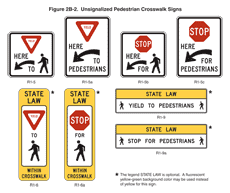
Guidance:
02 If yield (stop)lines and Yield Here To (Stop Here For) Pedestrians signs are used in advance of a crosswalk that crosses an uncontrolled multi-lane approach, they should be placed 20 to 50 feet in advance of the nearest crosswalk line (see Section 3B.16 and Figure 3B-17), and parking should be prohibited in the area between the yield (stop)line and the crosswalk.
03 Yield (stop)lines and Yield Here To (Stop Here For) Pedestrians signs should not be used in advance of crosswalks that cross an approach to or departure from a roundabout.
Option:
04 Yield Here To (Stop Here For) Pedestrians signs may be used in advance of a crosswalk that crosses an uncontrolled multi-lane approach to indicate to road users where to yield (stop) even if yield (stop) lines are not used.
05 A Pedestrian Crossing (W11-2) warning sign may be placed overhead or may be post-mounted with a diagonal downward pointing arrow (W16-7P) plaque at the crosswalk location where Yield Here To (Stop Here For) Pedestrians signs have been installed in advance of the crosswalk.
Standard:
06 If a W11-2 sign has been post-mounted at the crosswalk location where a Yield Here To (Stop Here For) Pedestrians sign is used on the approach, the Yield Here To (Stop Here For) Pedestrians sign shall not be placed on the same post as or block the road user's view of the W11-2 sign.
Option:
07 An advance Pedestrian Crossing (W11-2) warning sign with an AHEAD or a distance supplemental plaque may be used in conjunction with a Yield Here To (Stop Here For) Pedestrians sign on the approach to the same crosswalk.
08 In-Street Pedestrian Crossing signs and Yield Here To (Stop Here For) Pedestrians signs may be used together at the same crosswalk.
Section 2B.12 In-Street and Overhead Pedestrian Crossing Signs (R1-6, R1-6a, R1-9, and R1-9a)
Option:
01 The In-Street Pedestrian Crossing (R1-6 or R1-6a) sign (see Figure 2B-2) or the Overhead Pedestrian Crossing (R1-9 or R1-9a) sign (see Figure 2B-2) may be used to remind road users of laws regarding right-of-way at an unsignalized pedestrian crosswalk. The legend STATE LAW may be displayed at the top of the R1-6, R1-6a, R1-9, and R1-9a signs, if applicable. On the R1-6 and R1-6a signs, the legends STOP or YIELD may be used instead of the appropriate STOP sign or YIELD sign symbol.
02 Highway agencies may develop and apply criteria for determining the applicability of In-Street Pedestrian Crossing signs.
Standard:
03 If used, the In-Street Pedestrian Crossing sign shall be placed in the roadway at the crosswalk location on the center line, on a lane line, or on a median island. The In-Street Pedestrian Crossing sign shall not be post-mounted on the left-hand or right-hand side of the roadway.
04 If used, the Overhead Pedestrian Crossing sign shall be placed over the roadway at the crosswalk location.
05 An In-Street or Overhead Pedestrian Crossing sign shall not be placed in advance of the crosswalk to educate road users about the State law prior to reaching the crosswalk, nor shall it be installed as an educational display that is not near any crosswalk.
Guidance:
06 If an island (see Chapter 3I) is available, the In-Street Pedestrian Crossing sign, if used, should be placed on the island.
Option:
07 If a Pedestrian Crossing (W11-2) warning sign is used in combination with an In-Street or an Overhead Pedestrian Crossing sign, the W11-2 sign with a diagonal downward pointing arrow (W16-7P) plaque may be post-mounted on the right-hand side of the roadway at the crosswalk location.
Standard:
08 The In-Street Pedestrian Crossing sign and the Overhead Pedestrian Crossing sign shall not be used at signalized locations.
09 The STOP FOR legend shall only be used in States where the State law specifically requires that a driver must stop for a pedestrian in a crosswalk.
10 The In-Street Pedestrian Crossing sign shall have a black legend (except for the red STOP or YIELD sign symbols) and border on a white background, surrounded by an outer yellow or fluorescent yellow-green background area (see Figure 2B-2). The Overhead Pedestrian Crossing sign shall have a black legend and border on a yellow or fluorescent yellow-green background at the top of the sign and a black legend and border on a white background at the bottom of the sign (see Figure 2B-2).
11 Unless the In-Street Pedestrian Crossing sign is placed on a physical island, the sign support shall be designed to bend over and then bounce back to its normal vertical position when struck by a vehicle.
Support:
12 The Provisions of Section 2A.18 concerning mounting height are not applicable for the In-Street Pedestrian Crossing sign.
Standard:
13 The top of an In-Street Pedestrian Crossing sign shall be a maximum of 4 feet above the pavement surface. The top of an In-Street Pedestrian Crossing sign placed in an island shall be a maximum of 4 feet above the island surface.
Option:
14 The In-Street Pedestrian Crossing sign may be used seasonably to prevent damage in winter because of plowing operations, and may be removed at night if the pedestrian activity at night is minimal.
15 In-Street Pedestrian Crossing signs, Overhead Pedestrian Crossing signs, and Yield Here To (Stop Here For) Pedestrians signs may be used together at the same crosswalk.
Section 2B.13 Speed Limit Sign (R2-1)
Standard:
01 Speed zones (other than statutory speed limits) shall only be established on the basis of an engineering study that has been performed in accordance with traffic engineering practices. The engineering study shall include an analysis of the current speed distribution of free-flowing vehicles.
02 The Speed Limit (R2-1) sign (see Figure 2B-3) shall display the limit established by law, ordinance, regulation, or as adopted by the authorized agency based on the engineering study. The speed limits displayed shall be in multiples of 5 mph.
Figure 2B-3 Speed Limit and Photo Enforcement Signs and Plaques
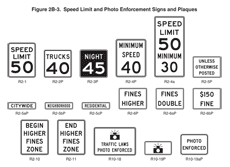
03 Speed Limit (R2-1) signs, indicating speed limits for which posting is required by law, shall be located at the points of change from one speed limit to another.
04 At the downstream end of the section to which a speed limit applies, a Speed Limit sign showing the next speed limit shall be installed. Additional Speed Limit signs shall be installed beyond major intersections and at other locations where it is necessary to remind road users of the speed limit that is applicable.
05 Speed Limit signs indicating the statutory speed limits shall be installed at entrances to the State and, where appropriate, at jurisdictional boundaries in urban areas.
Support:
06 In general, the maximum speed limits applicable to rural and urban roads are established:
- Statutorily – a maximum speed limit applicable to a particular class of road, such as freeways or city streets, that is established by State law; or
- As altered speed zones – based on engineering studies.
07 State statutory limits might restrict the maximum speed limit that can be established on a particular road, notwithstanding what an engineering study might indicate.
Option:
08 If a jurisdiction has a policy of installing Speed Limit signs in accordance with statutory requirements only on the streets that enter a city, neighborhood, or residential area to indicate the speed limit that is applicable to the entire city, neighborhood, or residential area unless otherwise posted, a CITYWIDE (R2-5aP), NEIGHBORHOOD (R2-5bP), or RESIDENTIAL (R2-5cP) plaque may be mounted above the Speed Limit sign and an UNLESS OTHERWISE POSTED (R2-5P) plaque may be mounted below the Speed Limit sign (see Figure 2B-3).
Guidance:
09 A Reduced Speed Limit Ahead (W3-5 or W3-5a) sign (see Section 2C.38) should be used to inform road users of a reduced speed zone where the speed limit is being reduced by more than 10 mph, or where engineering judgment indicates the need for advance notice to comply with the posted speed limit ahead.
10 States and local agencies should conduct engineering studies to reevaluate non-statutory speed limits on segments of their roadways that have undergone significant changes since the last review, such as the addition or elimination of parking or driveways, changes in the number of travel lanes, changes in the configuration of bicycle lanes, changes in traffic control signal coordination, or significant changes in traffic volumes.
11 No more than three speed limits should be displayed on any one Speed Limit sign or assembly.
12 When a speed limit within a speed zone is posted, it should be within 5 mph of the 85th-percentile speed of free-flowing traffic.
13 Speed studies for signalized intersection approaches should be taken outside the influence area of the traffic control signal, which is generally considered to be approximately 1/2 mile, to avoid obtaining skewed results for the 85th-percentile speed.
Support:
14 Advance warning signs and other traffic control devices to attract the motorist's attention to a signalized intersection are usually more effective than a reduced speed limit zone.
Guidance:
15 An advisory speed plaque (see Section 2C.08) mounted below a warning sign should be used to warn road users of an advisory speed for a roadway condition. A Speed Limit sign should not be used for this situation.
Option:
16 Other factors that may be considered when establishing or reevaluating speed limits are the following:
- Road characteristics, shoulder condition, grade, alignment, and sight distance;
- The pace;
- Roadside development and environment;
- Parking practices and pedestrian activity; and
- Reported crash experience for at least a 12-month period.
17 Two types of Speed Limit signs may be used: one to designate passenger car speeds, including any nighttime information or minimum speed limit that might apply; and the other to show any special speed limits for trucks and other vehicles.
18 A changeable message sign that changes the speed limit for traffic and ambient conditions may be installed provided that the appropriate speed limit is displayed at the proper times.
19 A changeable message sign that displays to approaching drivers the speed at which they are traveling may be installed in conjunction with a Speed Limit sign.
Guidance:
20 If a changeable message sign displaying approach speeds is installed, the legend YOUR SPEED XX MPH or such similar legend should be displayed. The color of the changeable message legend should be a yellow legend on a black background or the reverse of these colors.
Support:
21 Advisory Speed signs and plaques are discussed in Sections 2C.08 and 2C.14. Temporary Traffic Control Zone Speed signs are discussed in Part 6. The WORK ZONE (G20-5aP) plaque intended for installation above a Speed Limit sign is discussed in Section 6F.12. School Speed Limit signs are discussed in Section 7B.15.
Section 2B.14 Truck Speed Limit Plaque (R2-2P)
Standard:
01 Where a special speed limit applies to trucks or other vehicles, the legend TRUCKS XX or such similar legend shall be displayed below the legend Speed Limit XX on the same sign or on a separate R2-2P plaque (see Figure 2B-3) below the standard legend.
Section 2B.15 Night Speed Limit Plaque (R2-3P)
Standard:
01 Where different speed limits are prescribed for day and night, both limits shall be posted.
Guidance:
02 A Night Speed Limit (R2-3P) plaque (see Figure 2B-3) should be reversed using a white retroreflectorized legend and border on a black background.
Option:
03 A Night Speed Limit plaque may be combined with or installed below the standard Speed Limit (R2-1) sign.
Section 2B.16 Minimum Speed Limit Plaque (R2-4P)
Standard:
01 A Minimum Speed Limit (R2-4P) plaque (see Figure 2B-3) shall be displayed only in combination with a Speed Limit sign.
Option:
02 Where engineering judgment determines that slow speeds on a highway might impede the normal and reasonable movement of traffic, the Minimum Speed Limit plaque may be installed below a Speed Limit (R2-1) sign to indicate the minimum legal speed. If desired, the Speed Limit sign and the Minimum Speed Limit plaque may be combined on the R2-4a sign (see Figure 2B-3).
Section 2B.17 Higher Fines Signs and Plaque (R2-6P, R2-10, and R2-11)
Standard:
01 If increased fines are imposed for traffic violations within a designated zone of a roadway, a BEGIN HIGHER FINES ZONE (R2-10) sign (see Figure 2B-3) or a FINES HIGHER (R2-6P) plaque (see Figure 2B-3) shall be used to provide notice to road users. If used, the FINES HIGHER plaque shall be mounted below an applicable regulatory or warning sign in a temporary traffic control zone, a school zone, or other applicable designated zone.
02 If an R2-10 sign or an R2-6P plaque is posted to provide notice of increased fines for traffic violations, an END HIGHER FINES ZONE (R2-11) sign (see Figure 2B-3) shall be installed at the downstream end of the zone to provide notice to road users of the termination of the increased fines zone.
Guidance:
03 If used, the BEGIN HIGHER FINES ZONE sign or FINES HIGHER plaque should be located at the beginning of the temporary traffic control zone, school zone, or other applicable designated zone and just beyond any interchanges, major intersections, or other major traffic generators.
Standard:
04 The Higher Fines signs and plaque shall have a black legend and border on a white rectangular background. All supplemental plaques mounted below the Higher Fines signs and plaque shall have a black legend and border on a white rectangular background.
Guidance:
05 Agencies should limit the use of the Higher Fines signs and plaque to locations where work is actually underway, or to locations where the roadway, shoulder, or other conditions, including the presence of a school zone and/or a reduced school speed limit zone, require a speed reduction or extra caution on the part of the road user.
Option:
06 Alternate legends such as BEGIN (or END) DOUBLE FINES ZONE may also be used for the R2-10 and R2-11 signs.
07 The legend FINES HIGHER on the R2-6P plaque may be replaced by FINES DOUBLE (R2-6aP), $XX FINE (R2-6bP), or another legend appropriate to the specific regulation (see Figure 2B-3).
08 The following may be mounted below an R2-10 sign or R2-6P plaque:
- A supplemental plaque specifying the times that the higher fines are in effect (similar to the S4-1P plaque shown in Figure 7B-1), or
- A supplemental plaque WHEN CHILDREN (WORKERS) ARE PRESENT, or
- A supplemental plaque WHEN FLASHING (similar to the S4-4P plaque shown in Figure 7B-1) if used in conjunction with a yellow flashing beacon.
Support:
09 Section 6F.12 contains information regarding other signs and plaques associated with increased fines for traffic violations in temporary traffic control zones. Section 7B.10 contains information regarding other signs and plaques associated with increased fines for traffic violations in designated school zones.
Section 2B.18 Movement Prohibition Signs (R3-1 through R3-4, R3-18, and R3-27)
Standard:
01 Except as provided in Paragraphs 11 and 13, where specific movements are prohibited, Movement Prohibition signs shall be installed.
Guidance:
02 Movement Prohibition signs should be placed where they will be most easily seen by road users who might be intending to make the movement.
03 If No Right Turn (R3-1) signs (see Figure 2B-4) are used, at least one should be placed either over the roadway or at a right-hand corner of the intersection.
Figure 2B-4 Movement Prohibition and Lane Control Signs and Plaques
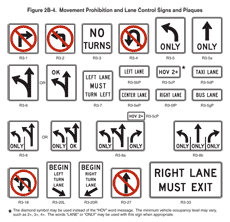
04 If No Left Turn (R3-2) signs (see Figure 2B-4) are used, at least one should be placed over the roadway, at the far left-hand corner of the intersection, on a median, or in conjunction with the STOP sign or YIELD sign located on the near right-hand corner.
05 Except as provided in Item C of Paragraph 9 for signalized locations, if NO TURNS (R3-3) signs (see Figure 2B-4) are used, two signs should be used, one at a location specified for a No Right Turn sign and one at a location specified for a No Left Turn sign.
06 If No U-Turn (R3-4) signs (see Figure 2B-4) or combination No U-Turn/No Left Turn (R3-18) signs (see Figure 2B-4) are used, at least one should be used at a location specified for No Left Turn signs.
Option:
07 If both left turns and U-turns are prohibited, the combination No U-Turn/No Left Turn (R3-18) sign (see Figure 2B-4) may be used instead of separate R3-2 and R3-4 signs.
Guidance:
08 If No Straight Through (R3-27) signs (see Figure 2B-4) are used, at least one should be placed either over the roadway or at a location where it can be seen by road users who might be intending to travel straight through the intersection.
09 If turn prohibition signs are installed in conjunction with traffic control signals:
- The No Right Turn sign should be installed adjacent to a signal face viewed by road users in the right-hand lane.
- The No Left Turn (or No U-Turn or combination No U-Turn/No Left Turn) sign should be installed adjacent to a signal face viewed by road users in the left-hand lane.
- A NO TURNS sign should be placed adjacent to a signal face viewed by all road users on that approach, or two signs should be used.
Option:
10 If turn prohibition signs are installed in conjunction with traffic control signals, an additional Movement Prohibition sign may be post-mounted to supplement the sign mounted overhead.
11 Where ONE WAY signs are used (see Section 2B.40), No Left Turn and No Right Turn signs may be omitted.
12 When the movement restriction applies during certain time periods only, the following Movement Prohibition signing alternatives may be used and are listed in order of preference:
- Changeable message signs, especially at signalized intersections.
- Permanently mounted signs incorporating a supplementary legend showing the hours and days during which the prohibition is applicable.
- Portable signs, installed by proper authority, located off the roadway at each corner of the intersection. The portable signs are only to be used during the time that the movement prohibition is applicable.
13 Movement Prohibition signs may be omitted at a ramp entrance to an expressway or a channelized intersection where the design is such as to indicate clearly the one-way traffic movement on the ramp or turning lane.
Standard:
14 The No Left Turn (R3-2) sign, the No U-Turn (R3-4) sign, and the combination No U-Turn/No Left Turn (R3-18) sign shall not be used at approaches to roundabouts to prohibit drivers from turning left onto the circulatory roadway of a roundabout.
Support:
15 At roundabouts, the use of R3-2, R3-4, or R3-18 signs to prohibit left turns onto the circulatory roadway might confuse drivers about the possible legal turning movements around the roundabout. Roundabout Directional Arrow (R6-4 series) signs (see Section 2B.43) and/or ONE WAY (R6-1R or R6-2R) signs are the appropriate signs to indicate the travel direction within a roundabout.
Section 2B.19 Intersection Lane Control Signs (R3-5 through R3-8)
Standard:
01 Intersection Lane Control signs, if used, shall require road users in certain lanes to turn, shall permit turns from a lane where such turns would otherwise not be permitted, shall require a road user to stay in the same lane and proceed straight through an intersection, or shall indicate permitted movements from a lane.
02 Intersection Lane Control signs (see Figure 2B-4) shall have three applications:
- Mandatory Movement Lane Control (R3-5, R3-5a, and R3-7) signs,
- Optional Movement Lane Control (R3-6) sign, and
- Advance Intersection Lane Control (R3-8 series) signs.
Guidance:
03 When Intersection Lane Control signs are mounted overhead, each sign should be placed over the lane or a projection of the lane to which it applies.
04 On signalized approaches where through lanes that become mandatory turn lanes, multiple-lane turns that include shared lanes for through and turning movements, or other lane-use regulations are present that would be unexpected by unfamiliar road users, overhead lane control signs should be installed at the signalized location over the appropriate lanes or projections thereof and in advance of the intersection over the appropriate lanes.
05 Where overhead mounting on the approach is impractical for the advance and/or intersection lane-use signs, one of the following alternatives should be employed:
- At locations where through lanes become mandatory turn lanes, a mandatory movement lane control (R3-7) sign should be post-mounted on the left-hand side of the roadway where a through lane is becoming a mandatory left-turn lane on a one-way street or where a median of sufficient width for the signs is available, or on the right-hand side of the roadway where a through lane is becoming a mandatory right-turn lane.
- At locations where a through lane is becoming a mandatory left-turn lane on a two-way street where a median of sufficient width for the signs is not available, and at locations where multiple-lane turns that include shared lanes for through and turning movements are present, an Advance Intersection Lane Control (R3-8 series) sign should be post-mounted in a prominent location in advance of the intersection, and consideration should be given to the use of an oversized version in accordance with Table 2B-1.
Standard:
06 Use of an overhead sign for one approach lane shall not require installation of overhead signs for the other lanes of that approach.
Option:
07 Where the number of through lanes on an approach is two or less, the Intersection Lane Control signs (R3-5, R3-6, or R3-8) may be overhead or post-mounted.
08 Intersection Lane Control signs may be omitted where:
- A turn bay has been provided by physical construction or pavement markings, and
- Only the road users using such turn bays are permitted to make a turn in that direction.
09 At roundabouts, Intersection Lane Control (R3-5, R3-6, and R3-8 series) signs may display any of the arrow symbol options shown in Figure 2B-5.
Figure 2B-5 Intersection Lane Control Sign Arrow Options for Roundabouts

Section 2B.20 Mandatory Movement Lane Control Signs (R3-5, R3-5a, R3-7, and R3-20)
Standard:
01 If used, the Mandatory Movement Lane Control (R3-5, R3-5a, and R3-7) sign (see Figure 2B-4) shall indicate only the single vehicle movement that is required from the lane. If used, the Mandatory Movement Lane Control sign shall be located in advance of the intersection, such as near the upstream end of the mandatory movement lane, and/or at the intersection where the regulation applies. When the mandatory movement applies to lanes exclusively designated for HOV traffic, the R3-5cP supplemental plaque shall be used. When the mandatory movement applies to lanes that are not HOV facilities, but are lanes exclusively designated for buses and/or taxis, the word message R3-5dP and/or R3-5gP supplemental plaques shall be used.
02 The Mandatory Movement Lane Control (R3-7) sign shall include the legend RIGHT (LEFT) LANE MUST TURN RIGHT (LEFT). The Mandatory Movement Lane Control (R3-5 and R3-5a) symbol signs shall include the legend ONLY.
03 The R3-7 word message sign shall be for post-mounting only.
04 Where the number of lanes available to through traffic on an approach is three or more, Mandatory Movement Lane Control (R3-5 and R3-5a) symbol signs, if used, shall be mounted overhead over the specific lanes to which they apply (see Section 2B.19).
Guidance:
05 If the R3-5 or R3-5a sign is post-mounted on an approach with two or fewer through lanes, a supplemental plaque (see Figure 2B-4), such as LEFT LANE (R3-5bP), HOV 2+ (R3-5cP), TAXI LANE (R3-5dP), CENTER LANE (R3-5eP), RIGHT LANE (R3-5fP), BUS LANE (R3-5gP), or BOTH LANES, should be added above the signto indicate the specific lane to which the mandatory movement applies. If Mandatory Lane Movement Control (R3-5) symbol signs with supplemental R3-5bP or R3-5fP plaques are used, they should be mounted adjacent to and along only the full width portion of the turn lane.
06 The use of the Mandatory Movement Lane Control (R3-7) word message sign should be limited to only locations that are adjacent to the full-width portion of a mandatory turn lane. The R3-7 sign should not be installed adjacent to a through lane in advance of a turn bay taper or adjacent to a turn bay taper.
07 Mandatory Movement Lane Control signs should be accompanied by lane-use arrow markings, especially where traffic volumes are high, where there is a high percentage of commercial vehicles, or where other distractions exist.
Option:
08 The Straight Through Only (R3-5a) sign may be used to require a road user in a particular lane to proceed straight through an intersection.
09 When the Mandatory Movement Lane Control sign for a left-turn lane is installed back-to-back with a Keep Right (R4-7) sign, the dimensions of the Mandatory Movement Lane Control (R3-5) sign may be the same as the Keep Right sign.
10 The diamond symbol may be used instead of the word message HOV on the R3-5cP supplemental plaque.
11 The BEGIN RIGHT TURN LANE (R3-20R) sign (see Figure 2B-4) may be post-mounted on the right-hand side of the roadway at the upstream end of the turn lane taper of a mandatory right-turn lane. The BEGIN LEFT TURN LANE (R3-20L) sign (see Figure 2B-4) may be post-mounted on a median (or on the left-hand side of the roadway for a one-way street) at the upstream end of the turn lane taper of a mandatory left-turn lane.
Section 2B.21 Optional Movement Lane Control Sign (R3-6)
Standard:
01 If used, the Optional Movement Lane Control (R3-6) sign (see Figure 2B-4) shall be used for two or more movements from a specific lane or to emphasize permitted movements. If used, the Optional Movement Lane Control sign shall be located in advance of the intersection, such as near the upstream end of an adjacent mandatory movement lane, and/or at the intersection where the regulation applies.
02 If used, the Optional Movement Lane Control sign shall indicate all permissible movements from specific lanes.
03 Optional Movement Lane Control signs shall be used for two or more movements from a specific lane where a movement, not normally allowed, is permitted.
04 The Optional Movement Lane Control sign shall not be used alone to effect a turn prohibition.
05 Where the number of lanes available to through traffic on an approach is three or more, an Optional Movement Lane Control (R3-6) sign, if used, shall be mounted overhead over the specific lane to which it applies (see Section 2B.19).
Guidance:
06 If the Optional Movement Lane Control sign is post-mounted on an approach with two or fewer through lanes, a supplemental plaque (see Figure 2B-4), such as LEFT LANE (R3-5bP), HOV 2+ (R3-5cP), TAXI LANE (R3-5dP), CENTER LANE (R3-5eP), RIGHT LANE (R3-5fP), or BUS LANE (R3-5gP), should be added above the R3-6 sign to indicate the specific lane from which the optional movements can be made.
Option:
07 The word message OK may be used within the border in combination with the arrow symbols of the R3-6 sign.
Standard:
08 Because more than one movement is permitted from the lane, the word message ONLY shall not be used on an Optional Movement Lane Control sign.
Section 2B.22 Advance Intersection Lane Control Signs (R3-8 Series)
Option:
01 Advance Intersection Lane Control (R3-8, R3-8a, and R3-8b) signs (see Figure 2B-4) may be used to indicate the configuration of all lanes ahead.
02 The word messages ONLY, OK, THRU, ALL, or HOV 2+ may be used within the border in combination with the arrow symbols of the R3-8 sign series. The HOV 2+ (R3-5cP) supplemental plaque may be installed at the top outside border of the R3-8 sign over the applicable lane designation on the sign. The diamond symbol may be used instead of the word message HOV. The minimum allowable vehicle occupancy requirement may vary based on the level established for a particular facility.
Guidance:
03 If used, an Advance Intersection Lane Control sign should be placed at an adequate distance in advance of the intersection so that road users can select the appropriate lane (see Figure 2A-4). If used, the Advance Intersection Lane Control sign should be installed either in advance of the tapers or at the beginning of the turn lane.
Option:
04 An Advance Intersection Lane Control sign may be repeated closer to the intersection for additional emphasis.
Standard:
05 Where three or more approach lanes are available to traffic, Advance Intersection Lane Control (R3-8 series) signs, if used, shall be post-mounted in advance of the intersection and shall not be mounted overhead (see Section 2B.19).
Section 2B.23 RIGHT (LEFT) LANE MUST EXIT Sign (R3-33)
Option:
01 A RIGHT (LEFT) LANE MUST EXIT (R3-33) sign (see Figure 2B-4) may be used to supplement an overhead EXIT ONLY guide sign to inform road users that traffic in the right-hand (left-hand) lane of a roadway that is approaching a grade-separated interchange is required to depart the roadway on the exit ramp at the next interchange.
Support:
02 Section 2C.43 contains information regarding a warning sign that can be used in advance of lane drops at grade-separated interchanges.
Section 2B.24 Two-Way Left Turn Only Signs (R3-9a, R3-9b)
Guidance:
01 Two-Way Left Turn Only (R3-9a or R3-9b) signs (see Figure 2B-6) should be used in conjunction with the required pavement markings where a non-reversible lane is reserved for the exclusive use of left-turning vehicles in either direction and is not used for passing, overtaking, or through travel.
Figure 2B-6 Center and Reversible Lane Control Signs and Plaques
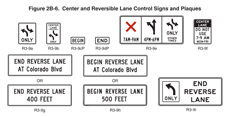
Option:
02 The post-mounted R3-9b sign may be used as an alternate to or a supplement to the overhead R3-9a sign. The legend BEGIN or END may be used within the border of the main sign itself, or on an R3-9cP or R3-9dP plaque (see Figure 2B-6) mounted immediately above it.
Support:
03 Signing is especially helpful to drivers in areas where the two-way left turn only maneuver is new, in areas subject to environmental conditions that frequently obscure the pavement markings, and on peripheral streets with two-way left turn only lanes leading to an extensive system of routes with two-way left turn only lanes.
Section 2B.25 BEGIN and END Plaques (R3-9cP, R3-9dP)
Option:
01 The BEGIN (R3-9cP) or END (R3-9dP) plaque (see Figure 2B-6) may be used to supplement a regulatory sign to inform road users of the location where a regulatory condition begins or ends.
Standard:
02 If used, the BEGIN or END plaque shall be mounted directly above a regulatory sign.
Section 2B.26 Reversible Lane Control Signs (R3-9e through R3-9i)
Option:
01 A reversible lane may be used for through traffic (with left turns either permitted or prohibited) in alternating directions during different periods of the day, and the lane may be used for exclusive left turns in one or both directions during other periods of the day as well. Reversible Lane Control (R3-9e through R3-9i) signs (see Figure 2B-6) may be either static type or changeable message type. These signs may be either post-mounted or overhead.
Standard:
02 post-mounted Reversible Lane Control signs shall be used only as a supplement to overhead signs or signals. post-mounted signs shall be identical in design to the overhead signs and an additional legend such as CENTER LANE shall be added to the sign (R3-9f) to indicate which lane is controlled. For both word messages and symbols, this legend shall be at the top of the sign.
03 Where it is determined by an engineering study that lane-use control signals or physical barriers are not necessary, the lane shall be controlled by overhead Reversible Lane Control signs (see Figure 2B-7).
Figure 2B-7 Location of Reversible Two-Way Left-Turn Signs
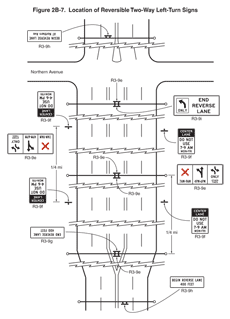
Option:
04 Reversing traffic flow may be controlled with pavement markings and Reversible Lane Control signs (without the use of lane control signals), when all of the following conditions are met:
- Only one lane is being reversed,
- An engineering study indicates that the use of Reversible Lane Control signs alone would result in an acceptable level of safety and efficiency, and
- There are no unusual or complex operations in the reversible lane pattern.
Standard:
05 Reversible Lane Control signs shall contain the legend or symbols designating the allowable uses of the lane and the time periods such uses are allowed. Where symbols and legends are used, their meanings shall be as shown in Table 2B-2.
| Symbol / Word Message | Meaning |
|---|---|
| Red X on white background | Lane closed |
| Upward pointing black arrow on white background (if left turns are permitted, the arrow shall be modified to show left / through arrow) | Lane open for through travel and any turns not otherwise prohibited |
| Black two-way left-turn arrows on white background and legend ONLY | Lane may be used only for left turns in either direction (i.e., as a two-way left-turn lane) |
| Black single left-turn arrow on white background and legend ONLY | Lane may be used only for left turns in one direction (without opposing left turns in the same lane) |
06 Reversible Lane Control signs shall consist of a white background with a black legend and border, except for the R3-9d sign, where the color red is used.
07 Symbol signs, such as the R3-9d sign, shall consist of the appropriate symbol in the upper portion of the sign with the appropriate times of the day and days of the week below it. All times of the day and days of the week shall be accounted for on the sign to eliminate confusion to the road user.
08 In situations where more than one message is conveyed to the road user, such as on the R3-9d sign, the sign legend shall be arranged as follows:
- The prohibition or restriction message is the primary legend and shall be on the top for word message signs and to the far left for symbol signs,
- The permissive use message shall be displayed as the second legend, and
- The OTHER TIMES message shall be displayed at the bottom for word message signs and to the far right for symbol signs.
Option:
09 The symbol signs may also include a downward pointing arrow with the legend THIS LANE. The term OTHER TIMES may be used for either the symbol or word message sign.
Standard:
10 A Reversible Lane Control sign shall be mounted over the center of the lane that is being reversed and shall be perpendicular to the roadway alignment.
11 If the vertical or horizontal alignment is curved to the degree that a driver would be unable to see at least one sign, and preferably two signs, then additional overhead signs shall be installed. The placement of the signs shall be such that the driver will have a definite indication of the lanes specifically reserved for use at any given time. Special consideration shall be given to major generators introducing traffic between the normal sign placement.
12 Transitions at the entry to and exit from a section of roadway with reversible lanes shall be carefully reviewed, and advance signs shall be installed to notify or warn drivers of the boundaries of the reversible lane controls. The R3-9g or R3-9h signs shall be used for this purpose.
Option:
13 More than one sign may be used at the termination of the reversible lane to emphasize the importance of the message (R3-9i).
Standard:
14 Flashing beacons, if used to accentuate the overhead Reversible Lane Control signs, shall comply with the applicable requirements for flashing beacons in Chapter 4L.
15 When used in conjunction with Reversible Lane Control signs, the Turn Prohibition signs (R3-1 to R3-4, R3-18) shall be mounted overhead and separate from the Reversible Lane Control signs. The Turn Prohibition signs shall be designed and installed in accordance with Section 2B.18.
Guidance:
16 For additional emphasis, a supplemental plaque stating the distance of the prohibition, such as NEXT 1 MILE, should be added to the Turn Prohibition signs that are used in conjunction with Reversible Lane Control signs.
17 If used, overhead signs should be located at intervals not greater than 1/4 mile. The bottom of the overhead Reversible Lane Control signs should not be more than 19 feet above the pavement grade.
18 Where more than one sign is used at the termination of a reversible lane, they should be at least 250 feet apart. Longer distances between signs are appropriate for streets with speeds over 35 mph, but the separation should not exceed 1,000 feet.
19 Because left-turning vehicles have a significant impact on the safety and efficiency of a reversible lane operation, if an exclusive left-turn lane or two-way left-turn lane cannot be incorporated into the lane-use pattern for a particular peak or off-peak period, consideration should be given to prohibiting left turns and U-turns during that time period.
Section 2B.27 Jughandle Signs (R3-23, R3-24, R3-25, and R3-26 Series)
Support:
01 A jughandle turn is a left-turn or U-turn that because of special geometry is made by initially making a right turn. This type of turn can increase the operational efficiency of a roadway by eliminating the need for exclusive left-turn lanes and can increase the operational efficiency of a traffic control signal by eliminating the need for protected left-turn phases. A jughandle turn can also provide an opportunity for trucks and commercial vehicles to make a U-turn where the median and roadway are not of sufficient width to accommodate a traditional U-turn by these vehicles.
02 Figure 2B-8 shows the various signs that can be used for signing jughandle turns. Figure 2B-9 shows examples of regulatory and destination guide signing for various types of jughandle turns.
Figure 2B-8 Jughandle Regulatory Signs
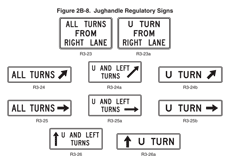
Figure 2B-9 Examples of Applications of Jughandle Regulatory and Guide Signing
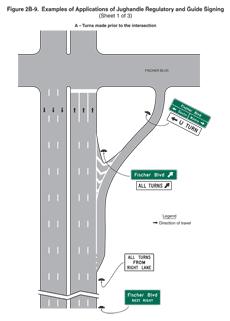
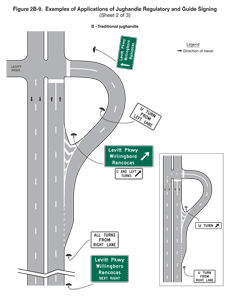
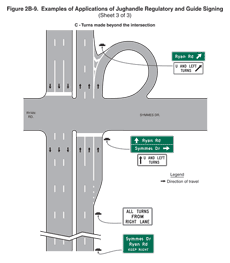
Standard:
03 On multi-lane roadways, since road users generally anticipate that they need to be in the left-hand lane when approaching a location where they desire to turn left or make a U-turn, an ALL TURNS FROM RIGHT LANE (R3-23) or a U TURN FROM RIGHT LANE (R3-23a) sign (see Figure 2B-9) shall be installed in advance of the location to inform drivers that left turns and/or U-turns will be made from the right-hand lane.
Option:
04 Where a median of sufficient width is available, supplemental regulatory or guide signs may also be placed on the left-hand side of the roadway.
Standard:
05 An R3-24 series sign with an upward diagonal arrow pointing to the right if the jughandle entrance is designed as an exit ramp (see Drawings A and B of Figure 2B-9) or an R3-25 series sign with a horizontal arrow pointing to the right if the jughandle entrance is designed as an intersection shall be installed on the right-hand side of the roadway at the entrance to the jughandle. The legend on the sign shall be ALL TURNS, U TURN, or U AND LEFT TURNS, as appropriate.
06 If the jughandle is designed such that the jughandle entrance is downstream of the location where the turn would normally have been made (see Drawing C of Figure 2B-9), an R3-26 series sign with an arrow pointing straight upward shall be installed on the right-hand side of the roadway at the intersection to inform road users that they need to proceed straight through the intersection in order to make a left turn or U-turn. The legend on the sign shall be U TURN or U AND LEFT TURNS, as appropriate.
Support:
07 The R3-24, R3-25, and R3-26 series of signs are designed to be mounted below conventional guide signs.
08 Section 2C.14 contains information regarding the use of advisory exit and ramp speed signs for exit ramps.
09 Section 2D.39 contains information regarding the use of guide signs for jughandles.
Section 2B.28 Do Not Pass Sign (R4-1)
Option:
01 The Do Not Pass (R4-1) sign (see Figure 2B-10) may be used in addition to pavement markings (see Section 3B.02) to emphasize the restriction on passing. The Do Not Pass sign may be used at the beginning of, and at intervals within, a zone through which sight distance is restricted or where other conditions make overtaking and passing inappropriate.
Figure 2B-10 Passing, Keep Right, and Slow Traffic Signs
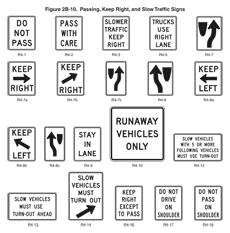
02 If signing is needed on the left-hand side of the roadway for additional emphasis, NO PASSING ZONE (W14-3) signs may be used (see Section 2C.45).
Support:
03 Standards for determining the location and extent of no-passing zone pavement markings are set forth in Section 3B.02.
Section 2B.29 PASS WITH CARE Sign (R4-2)
Guidance:
01 The PASS WITH CARE (R4-2) sign (see Figure 2B-10) should be installed at the downstream end of a no-passing zone if a Do Not Pass sign has been installed at the upstream end of the zone.
Section 2B.30 KEEP RIGHT EXCEPT TO PASS Sign (R4-16) and SLOWER TRAFFIC KEEP RIGHT Sign (R4-3)
Option:
01 The KEEP RIGHT EXCEPT TO PASS (R4-16) sign (see Figure 2B-10) may be used on multi-lane roadways to direct drivers to stay in the right-hand lane except when they are passing another vehicle.
Guidance:
02 If used, the KEEP RIGHT EXCEPT TO PASS sign should be installed just beyond the beginning of a multi-lane roadway and at selected locations along multi-lane roadways for additional emphasis.
Option:
03 The SLOWER TRAFFIC KEEP RIGHT (R4-3) sign (see Figure 2B-10) may be used on multi-lane roadways to reduce unnecessary lane changing.
Guidance:
04 If used, the SLOWER TRAFFIC KEEP RIGHT sign should be installed just beyond the beginning of a multi-lane pavement, and at selected locations where there is a tendency on the part of some road users to drive in the left-hand lane (or lanes) below the normal speed of traffic. This sign should not be used on the approach to an interchange or through an interchange area.
Section 2B.31 TRUCKS USE RIGHT LANE Sign (R4-5)
Guidance:
01 If an extra lane has been provided for trucks and other slow-moving traffic, a SLOWER TRAFFIC KEEP RIGHT (R4-3) sign (see Figure 2B-10), TRUCKS USE RIGHT LANE (R4-5) sign (see Figure 2B-10), or other appropriate sign should be installed at the beginning of the lane.
Option:
02 The SLOWER TRAFFIC KEEP RIGHT sign may be used as a supplement or as an alternative to the TRUCKS USE RIGHT LANE sign. Both signs may be used on multi-lane roadways to improve capacity and reduce lane changing.
03 The TRUCKS USE RIGHT LANE (R4-5) sign may be used on multi-lane roadways to reduce unnecessary lane changing.
Guidance:
04 If an extra lane has been provided for trucks and other slow-moving traffic, a Lane Ends sign (see Section 2C.42) should be installed in advance of the point where the extra lane ends. Appropriate pavement markings should be installed at both the upstream and downstream ends of the extra lane (see Section 3B.09 and Figure 3B-13).
Support:
05 Section 2D.51 contains information regarding advance information signs for extra lanes that have been provided for trucks and other slow-moving traffic.
Section 2B.32 Keep Right and Keep Left Signs (R4-7, R4-8)
Option:
01 The Keep Right (R4-7) sign (see Figure 2B-10) may be used at locations where it is necessary for traffic to pass only to the right-hand side of a roadway feature or obstruction. The Keep Left (R4-8) sign (see Figure 2B-10) may be used at locations where it is necessary for traffic to pass only to the left-hand side of a roadway feature or obstruction.
Guidance:
02 At locations where it is not readily apparent that traffic is required to keep to the right, a Keep Right sign should be used.
03 If used, the Keep Right sign should be installed as close as practical to approach ends of raised medians, parkways, islands, and underpass piers. The sign should be mounted on the face of or just in front of a pier or other obstruction separating opposite directions of traffic in the center of the highway such that traffic will have to pass to the right-hand side of the sign.
Standard:
04 The Keep Right sign shall not be installed on the right-hand side of the roadway in a position where traffic must pass to the left-hand side of the sign.
Option:
05 The Keep Right sign may be omitted at intermediate ends of divisional islands and medians.
06 Word message KEEP RIGHT (LEFT) with an arrow (R4-7a or R4-7b) signs (see Figure 2B-10) may be used instead of the R4-7 or R4-8 symbol signs.
07 Where the obstruction obscures the Keep Right sign, the minimum placement height may be increased for better sign visibility.
08 A narrow Keep Right (R4-7c) sign (see Figure 2B-10) may be installed on the approach end of a median island that is less than 4 feet wide at the point where the sign is to be located.
Standard:
09 A narrow Keep Right (R4-7c) sign shall not be installed on a median island that has a width of 4 feet or more at the point where the sign is to be located.
Section 2B.33 STAY IN LANE Sign (R4-9)
Option:
01 A STAY IN LANE (R4-9) sign (see Figure 2B-10) may be used on multi-lane highways to direct road users to stay in their lane until conditions permit shifting to another lane.
Guidance:
02 If a STAY IN LANE sign is used, it should be accompanied by a double solid white lane line(s) to prohibit lane changing.
Section 2B.34 RUNAWAY VEHICLES ONLY Sign (R4-10)
Guidance:
01 A RUNAWAY VEHICLES ONLY (R4-10) sign (see Figure 2B-10) should be installed near a truck escape (or runaway truck) ramp entrance to discourage other road users from entering the ramp.
Section 2B.35 Slow Vehicle Turn-Out Signs (R4-12, R4-13, and R4-14)
Support:
01 On two-lane highways in areas where traffic volumes and/or vertical or horizontal curvature make passing difficult, turn-out areas are sometimes provided for the purpose of giving a group of faster vehicles an opportunity to pass a slow-moving vehicle.
Option:
02 A SLOW VEHICLES WITH XX OR MORE FOLLOWING VEHICLES MUST USE TURN-OUT (R4-12) sign (see Figure 2B-10) may be installed in advance of a turn-out area to inform drivers who are driving so slow that they have accumulated a specific number of vehicles behind them that they are required by the traffic laws of that State to use the turn-out to allow the vehicles following them to pass.
Support:
03 The specific number of vehicles displayed on the R4-12 sign provides law enforcement personnel with the information they need to enforce this regulation.
Option:
04 If an R4-12 sign has been installed in advance of a turn-out area, a SLOW VEHICLES MUST USE TURN-OUT AHEAD (R4-13) sign (see Figure 2B-10) may also be installed downstream from the R4-12 sign, but upstream from the turn-out area, to remind slow drivers that they are required to use a turn-out that is a short distance ahead.
Standard:
05 If an R4-12 sign has been installed in advance of a turn-out area, a SLOW VEHICLES MUST TURN OUT (with arrow) (R4-14) sign (see Figure 2B-10) shall be installed at the entry point of the turn-out area.
Support:
06 Section 2D.52 contains information regarding advance information signs for slow vehicle turn-out areas.
Section 2B.36 DO NOT DRIVE ON SHOULDER Sign (R4-17) and DO NOT PASS ON SHOULDER Sign (R4-18)
Option:
01 The DO NOT DRIVE ON SHOULDER (R4-17) sign (see Figure 2B-10) may be installed to inform road users that using the shoulder of a roadway as a travel lane is prohibited.
02 The DO NOT PASS ON SHOULDER (R4-18) sign (see Figure 2B-10) may be installed to inform road users that using the shoulder of a roadway to pass other vehicles is prohibited.
Section 2B.37 DO NOT ENTER Sign (R5-1)
Standard:
01 The DO NOT ENTER (R5-1) sign (see Figure 2B-11) shall be used where traffic is prohibited from entering a restricted roadway.
Figure 2B-11 Selective Exclusion Signs

Guidance:
02 The DO NOT ENTER sign, if used, should be placed directly in view of a road user at the point where a road user could wrongly enter a divided highway, one-way roadway, or ramp (see Figure 2B-12). The sign should be mounted on the right-hand side of the roadway, facing traffic that might enter the roadway or ramp in the wrong direction.
Figure 2B-12 Locations of Wrong-Way Signing for Divided Highways with Median Widths of 30 Feet or Wider
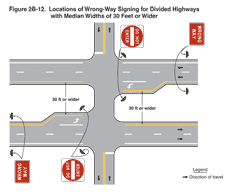
03 If the DO NOT ENTER sign would be visible to traffic to which it does not apply, the sign should be turned away from, or shielded from, the view of that traffic.
Option:
04 The DO NOT ENTER sign may be installed where it is necessary to emphasize the one-way traffic movement on a ramp or turning lane.
05 A second DO NOT ENTER sign on the left-hand side of the roadway may be used, particularly where traffic approaches from an intersecting roadway (see Figure 2B-12).
Support:
06 Section 2B.41 contains information regarding an optional lower mounting height for DO NOT ENTER signs that are located along an exit ramp facing a road user who is traveling in the wrong direction.
Section 2B.38 WRONG WAY Sign (R5-1a)
Option:
01 The WRONG WAY (R5-1a) sign (see Figure 2B-11) may be used as a supplement to the DO NOT ENTER sign where an exit ramp intersects a crossroad or a crossroad intersects a one-way roadway in a manner that does not physically discourage or prevent wrong-way entry (see Figure 2B-12).
Guidance:
02 If used, the WRONG WAY sign should be placed at a location along the exit ramp or the one-way roadway farther from the crossroad than the DO NOT ENTER sign (see Section 2B.41).
Support:
03 Section 2B.41 contains information regarding an optional lower mounting height for WRONG WAY signs that are located along an exit ramp facing a road user who is traveling in the wrong direction.
Section 2B.39 Selective Exclusion Signs
Support:
01 Selective Exclusion signs (see Figure 2B-11) give notice to road users that State or local statutes or ordinances exclude designated types of traffic from using particular roadways or facilities.
Standard:
02 If used, Selective Exclusion signs shall clearly indicate the type of traffic that is excluded.
Support:
03 Typical exclusion messages include:
- No Trucks (R5-2),
- NO MOTOR VEHICLES (R5-3),
- NO COMMERCIAL VEHICLES (R5-4),
- NO TRUCKS (VEHICLES) WITH LUGS (R5-5),
- No Bicycles (R5-6),
- NO NON-MOTORIZED TRAFFIC (R5-7),
- NO MOTOR-DRIVEN CYCLES (R5-8),
- No Pedestrians (R9-3),
- No Skaters (R9-13),
- No Equestrians (R9-14), and
- No Hazardous Material (R14-3) (see Section 2B.62).
Option:
04 Appropriate combinations or groupings of these legends into a single sign, such as NO PEDESTRIANS BICYCLES MOTOR-DRIVEN CYCLES (R5-10a), or NO PEDESTRIANS OR BICYCLES (R5-10b) may be used.
Guidance:
05 If an exclusion is governed by vehicle weight, a Weight Limit sign (see Section 2B.59) should be used instead of a Selective Exclusion sign.
06 If used on a freeway or expressway ramp, the NO PEDESTRIANS OR BICYCLES (R5-10b) sign should be installed in a location where it is clearly visible to any pedestrian or bicyclist attempting to enter the limited access facility from a street intersecting the exit ramp.
07 The Selective Exclusion sign should be placed on the right-hand side of the roadway at an appropriate distance from the intersection so as to be clearly visible to all road users turning into the roadway that has the exclusion. The NO PEDESTRIANS (R5-10c) or No Pedestrian Crossing (R9-3) sign (see Section 2B.51) should be installed so as to be clearly visible to pedestrians who are at a location where an alternative route is available.
Option:
08 The NO PEDESTRIANS (R5-10c) or No Pedestrian Crossing (R9-3) sign may also be used at underpasses or elsewhere where pedestrian facilities are not provided.
09 The NO TRUCKS (R5-2a) word message sign may be used as an alternate to the No Trucks (R5-2) symbol sign.
10 The AUTHORIZED VEHICLES ONLY (R5-11) sign may be used at median openings and other locations to prohibit vehicles from using the median opening or facility unless they have special permission (such as law enforcement vehicles or emergency vehicles) or are performing official business (such as highway agency vehicles).
Section 2B.40 ONE WAY Signs (R6-1, R6-2)
Standard:
01 Except as provided in Paragraph 6, the ONE WAY (R6-1 or R6-2) sign (see Figure 2B-13) shall be used to indicate streets or roadways upon which vehicular traffic is allowed to travel in one direction only.
Figure 2B-13 ONE WAY and Divided Highway Crossing Signs
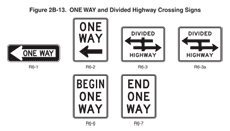
02 ONE WAY signs shall be placed parallel to the one-way street at all alleys and roadways that intersect one-way roadways as shown in Figure 2B-14.
Figure 2B-14 Locations of ONE WAY Signs
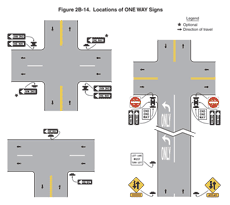
03 At an intersection with a divided highway that has a median width at the intersection itself of 30 feet or more, ONE WAY signs shall be placed, visible to each crossroad approach, on the near right and far left corners of each intersection with the directional roadways (see Figure 2B-15).
Figure 2B-15 ONE WAY Signing for Divided Highways with Medians of 30 Feet or Wider
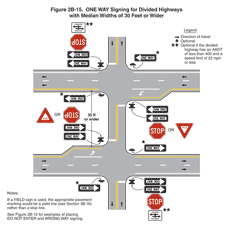
04 At an intersection with a divided highway that has a median width at the intersection itself of less than 30 feet, Keep Right (R4-7) signs and/or ONE WAY signs shall be installed (see Figures 2B-16 and 2B-17). If Keep Right signs are installed, they shall be placed as close as practical to the approach ends of the medians and shall be visible to traffic on the divided highway and each crossroad approach. If ONE WAY signs are installed, they shall be placed on the near right and far left corners of the intersection and shall be visible to each crossroad approach.
Figure 2B-16 ONE WAY Signing for Divided Highways with Median Widths Narrower Than 30 Feet
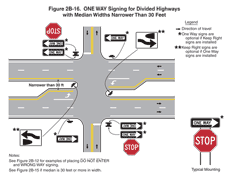
Figure 2B-17 ONE WAY Signing for Divided Highways with Median Widths Narrower Than 30 Feet and Separated Left-Turn Lanes
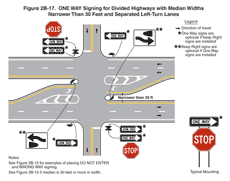
Option:
05 At an intersection with a divided highway that has a median width at the intersection itself of less than 30 feet, ONE WAY signs may also be placed on the far right corner of the intersection as shown in Figures 2B-16 and 2B-17.
06 ONE WAY signs may be omitted on the one-way roadways of divided highways, where the design of interchanges indicates the direction of traffic on the separate roadways.
Standard:
07 If used at unsignalized intersections with one-way streets, ONE WAY signs shall be placed on the near right and the far left corners of the intersection facing traffic entering or crossing the one-way street (see Figure 2B-14).
08 If used at signalized intersections with one-way streets, ONE WAY signs shall be placed near the appropriate signal faces, on the poles holding the traffic signals, on the mast arm or span wire holding the signals, or at the locations specified for unsignalized intersections.
09 At unsignalized T-intersections where the roadway at the top of the T-intersection is a one-way roadway, ONE WAY signs shall be placed on the near right and the far side of the intersection facing traffic on the stem approach (see Figure 2B-14).
10 At signalized T-intersections where the roadway at the top of the T-intersection is a one-way roadway, ONE WAY signs shall be placed near the appropriate signal faces, on the poles holding the traffic signals, on the mast arm or span wire holding the signals, or at the locations specified for unsignalized intersections.
Option:
11 Where the central island of a roundabout allows for the installation of signs, ONE WAY signs may be used instead of or in addition to Roundabout Directional Arrow (R6-4 series) signs (see Section 2B.43) to direct traffic counter-clockwise around the central island.
Guidance:
12 Where used on the central island of a roundabout, the mounting height of a ONE WAY sign should be at least 4 feet, measured vertically from the bottom of the sign to the elevation of the near edge of the traveled way.
Support:
13 Using ONE WAY signs on the central island of a roundabout might result in some drivers incorrectly concluding that the cross street is a one-way street. Using Roundabout Directional Arrow signs might reduce this confusion. However, using ONE WAY signs might be necessary in States that have defined a roundabout as a series of T-intersections.
Option:
14 The BEGIN ONE WAY (R6-6) sign (see Figure 2B-13) may be used notify road users of the beginning point of a one direction of travel restriction on the street or roadway. The END ONE WAY (R6-7) sign (see Figure 2B-13) may be used notify road users of the ending point of a one direction of travel restriction on the street or roadway.
Section 2B.41 Wrong-Way Traffic Control at Interchange Ramps
Standard:
01 At interchange exit ramp terminals where the ramp intersects a crossroad in such a manner that wrong-way entry could inadvertently be made, the following signs shall be used (see Figure 2B-18):
Figure 2B-18 Example of Application of Regulatory Signing and Pavement Markings at an Exit Ramp Termination to Deter Wrong-Way Entry
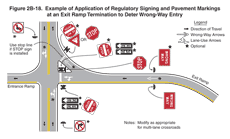
- At least one ONE WAY sign for each direction of travel on the crossroad shall be placed where the exit ramp intersects the crossroad.
- At least one DO NOT ENTER sign shall be conspicuously placed near the downstream end of the exit ramp in positions appropriate for full view of a road user starting to enter wrongly from the crossroad.
- At least one WRONG WAY sign shall be placed on the exit ramp facing a road user traveling in the wrong direction.
Guidance:
02 In addition, the following pavement markings should be used (see Figure 2B-18):
- On two-lane paved crossroads at interchanges, double solid yellow lines should be used as a center line for an adequate distance on both sides approaching the ramp intersections.
- Where crossroad channelization or ramp geometrics do not make wrong-way movements difficult, a lane-use arrow should be placed in each lane of an exit ramp near the crossroad terminal where it will be clearly visible to a potential wrong-way road user.
Option:
03 The following traffic control devices may be used to supplement the signs and pavement markings described in Paragraphs 1 and 2:
- Additional ONE WAY signs may be placed, especially on two-lane rural crossroads, appropriately in advance of the ramp intersection to supplement the required ONE WAY sign(s).
- Additional WRONG WAY signs may be used.
- Slender, elongated wrong-way arrow pavement markings (see Figure 3B-24) intended primarily to warn wrong-way road users that they are traveling in the wrong direction may be placed upstream from the ramp terminus (see Figure 2B-18) to indicate the correct direction of traffic flow. Wrong-way arrow pavement markings may also be placed on the exit ramp at appropriate locations near the crossroad junction to indicate wrong-way movement. The wrong-way arrow markings may consist of pavement markings or bidirectional red-and-white raised pavement markers or other units that show red to wrong-way road users and white to other road users (see Figure 3B-24).
- Lane-use arrow pavement markings may be placed on the exit ramp and crossroad near their intersection to indicate the permissive direction of flow.
- Freeway entrance signs (see Section 2D.46) may be used.
Guidance:
04 On interchange entrance ramps where the ramp merges with the through roadway and the design of the interchange does not clearly make evident the direction of traffic on the separate roadways or ramps, a ONE WAY sign visible to traffic on the entrance ramp and through roadway should be placed on each side of the through roadway near the entrance ramp merging point as illustrated in Figure 2B-19.
Figure 2B-19 Example of Application of Regulatory Signing and Pavement Markings at an Entrance Ramp Terminal Where the Design Does Not Clearly Indicate the Direction of Flow
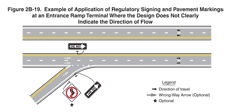
Option:
05 At locations where engineering judgment determines that a special need exists, other standard warning or prohibitive methods and devices may be used as a deterrent to the wrong-way movement.
06 Where there are no parked cars, pedestrian activity or other obstructions such as snow or vegetation, and if an engineering study indicates that a lower mounting height would address wrong-way movements on freeway or expressway exit ramps, a DO NOT ENTER sign(s) and/or a WRONG WAY sign(s) that is located along the exit ramp facing a road user who is traveling in the wrong direction may be installed at a minimum mounting height of 3 feet, measured vertically from the bottom of the sign to the elevation of the near edge of the pavement.
Support:
07 Section 2B.41 contains further information on signing to avoid wrong-way movements at at-grade intersections on expressways.
Section 2B.42 Divided Highway Crossing Signs (R6-3, R6-3a)
Standard:
01 On unsignalized minor-street approaches from which both left turns and right turns are permitted onto a divided highway that has a median width at the intersection itself of 30 feet or more, except as provided in Paragraph 2, a Divided Highway Crossing (R6-3 or R6-3a) sign (see Figure 2B-13) shall be used to advise road users that they are approaching an intersection with a divided highway (see Figure 2B-15).
Option:
02 If the divided highway that has a median width at the intersection itself of 30 feet or more has a traffic volume of less than 400 AADT and a speed limit of 25 mph or less, the Divided Highway Crossing signs facing the unsignalized minor-street approaches may be omitted.
03 A Divided Highway Crossing sign may be used on signalized minor-street approaches from which both left turns and right turns are permitted onto a divided highway to advise road users that they are approaching an intersection with a divided highway.
Standard:
04 If a Divided Highway Crossing sign is used at a four-legged intersection, the R6-3 sign shall be used. If used at a T-intersection, the R6-3a sign shall be used.
05 The Divided Highway Crossing sign shall be located on the near right corner of the intersection, mounted beneath a STOP or YIELD sign or on a separate support.
Option:
06 An additional Divided Highway Crossing sign may be installed on the left-hand side of the approach to supplement the Divided Highway Crossing sign on the near right corner of the intersection.
Section 2B.43 Roundabout Directional Arrow Signs (R6-4, R6-4a, and R6-4b)
Guidance:
01 Where the central island of a roundabout allows for the installation of signs, Roundabout Directional Arrow (R6-4 series) signs (see Figure 2B-20) should be used in the central island to direct traffic counter-clockwise around the central island, except as provided in Paragraph 11 in Section 2B.40.
Figure 2B-20 Roundabout Signs and Plaques

Standard:
02 The R6-4 sign shall be a horizontal rectangle with two black chevron symbols pointing to the right on a white background. The R6-4a sign shall be a horizontal rectangle with three black chevron symbols pointing to the right on a white background. The R6-4b sign shall be a horizontal rectangle with four black chevron symbols pointing to the right on a white background. No border shall be used on the Roundabout Directional Arrow signs.
03 Roundabout Directional Arrow signs shall be used only at roundabouts and other circular intersections.
Guidance:
04 When used on the central island of a roundabout, the mounting height of a Roundabout Directional Arrow sign should be at least 4 feet, measured vertically from the bottom of the sign to the elevation of the near edge of the traveled way.
Option:
05 More than one Roundabout Directional Arrow sign and/or R6-4a or R6-4b signs may be used facing high-speed approaches, facing approaches with limited visibility, or in other circumstances as determined by engineering judgment where increased sign visibility would be appropriate.
Section 2B.44 Roundabout Circulation Plaque (R6-5P)
Guidance:
01 Where the central island of a roundabout does not provide a reasonable place to install a sign, Roundabout Circulation (R6-5P) plaques (see Figure 2B-20) should be placed below the YIELD signs on each approach.
Option:
02 At roundabouts where Roundabout Directional Arrow signs and/or ONE WAY signs have been installed in the central island, Roundabout Circulation plaques may be placed below the YIELD signs on approaches to roundabouts to supplement the central island signs.
03 The Roundabout Circulation plaque may be used at any type of circular intersection.
Section 2B.45 Examples of Roundabout Signing
Support:
01 Figures 2B-21 through 2B-23 illustrate examples of regulatory and warning signing for roundabouts of various configurations.
Figure 2B-21 Example of Regulatory and Warning Signs for a Mini-Roundabout
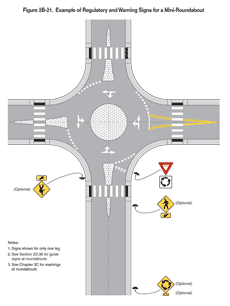
Figure 2B-22 Example of Regulatory and Warning Signs for a One-Lane Roundabout
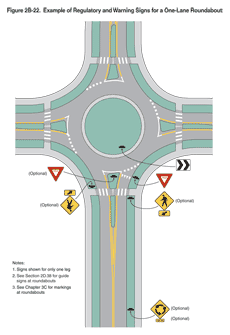
Figure 2B-23 Example of Regulatory and Warning Signs for a Two-Lane Roundabout with Consecutive Double Lefts
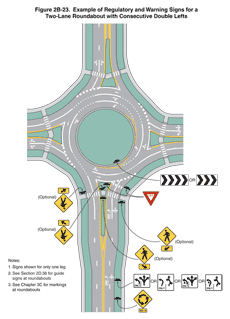
02 Section 2D.38 contains information regarding guide signing at roundabouts and Chapter 3C contains information regarding pavement markings at roundabouts.
Section 2B.46 Parking, Standing, and Stopping Signs (R7 and R8 Series)
Support:
01 Signs governing the parking, stopping, and standing of vehicles cover a wide variety of regulations, and only general guidance can be provided here. The word "standing" when used on the R7 and R8 series of signs refers to the practice of a driver keeping the vehicle in a stationary position while continuing to occupy the vehicle. Typical examples of parking, stopping, and standing signs and plaques (see Figures 2B-24 and 2B-25) are as follows:
- NO PARKING ANY TIME (R7-1);
- NO PARKING X:XX AM TO X:XX PM (R7-2, R7-2a);
- NO PARKING EXCEPT SUNDAYS AND HOLIDAYS (R7-3);
- NO STANDING ANY TIME (R7-4);
- XX HOUR PARKING X:XX AM – X:XX PM (R7-5);
- NO PARKING LOADING ZONE (R7-6);
- NO PARKING BUS STOP (R7-7, R7-107, R7-107a);
- RESERVED PARKING for persons with disabilities (R7-8);
- VAN ACCESSIBLE (R7-8P);
- Pay Station (R7-20);
- Pay Parking (R7-21, R7-21a, R7-22);
- Parking Permitted X:XX AM TO X:XX PM (R7-23);
- Parking Permitted XX HOUR(S) XX AM – XX PM (R7-23a);
- XX HR PARKING X:XX AM TO X:XX PM (R7-108);
- NO PARKING ANYTIME/XX HOUR PARKING X:XX AM – X:XX PM (R7-200, R7-200a);
- TOW-AWAY ZONE (R7-201P, R7-201aP);
- THIS SIDE OF SIGN (R7-202P);
- EMERGENCY SNOW ROUTE NO PARKING IF OVER XX INCHES (R7-203);
- NO PARKING ON PAVEMENT (R8-1);
- NO PARKING EXCEPT ON SHOULDER (R8-2);
- No Parking (R8-3, R8-3a);
- EXCEPT SUNDAYS & HOLIDAYS (R8-3bP);
- ON PAVEMENT (R8-3cP);
- ON BRIDGE (R8-3dP);
- ON TRACKS (R8-3eP);
- EXCEPT ON SHOULDER (R8-3fP);
- LOADING ZONE (R8-3gP);
- X:XX AM TO X:XX PM (R8-3hP);
- EMERGENCY PARKING ONLY (R8-4);
- NO STOPPING ON PAVEMENT (R8-5);
- NO STOPPING EXCEPT ON SHOULDER (R8-6); and
- EMERGENCY STOPPING ONLY (R8-7).
Figure 2B-24 Parking and Standing Signs and Plaques (R7 Series)
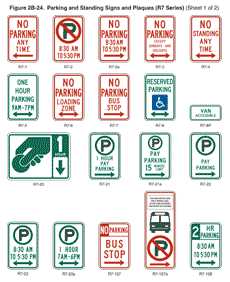
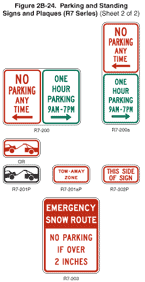
Figure 2B-25 Parking and Stopping Signs and Plaques (R8 Series)
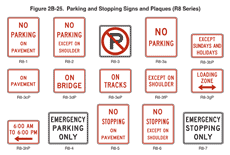
Section 2B.47 Design of Parking, Standing, and Stopping Signs
Support:
01 Discussions of parking signs and parking regulations in this Section apply not only to parking, but also to standing and stopping.
Standard:
02 The legend on parking signs shall state applicable regulations. Parking signs (see Figures 2B-24 and 2B-25) shall comply with the standards of shape, color, and location.
03 Where parking is prohibited at all times or at specific times, the basic design for parking signs shall have a red legend and border on a white background (Parking Prohibition signs), except that the R8-4 and R8-7 signs and the alternate design for the R7-201aP plaque shall have a black legend and border on a white background, and the R8-3 sign shall have a black legend and border and a red circle and slash on a white background.
04 Where only limited-time parking or parking in a particular manner are permitted, the signs shall have a green legend and border on a white background (Permissive Parking signs).
Guidance:
05 Parking signs should display the following information from top to bottom of the sign, in the order listed:
- The restriction or prohibition;
- The times of the day that it is applicable, if not at all hours; and
- The days of the week that it is applicable, if not every day.
06 If the parking restriction applies to a limited area or zone, the limits of the restriction should be shown by arrows or supplemental plaques. If arrows are used and if the sign is at the end of a parking zone, there should be a single-headed arrow pointing in the direction that the regulation is in effect. If the sign is at an intermediate point in a zone, there should be a double-headed arrow pointing both ways. When a single sign is used at the transition point between two parking zones, it should display a right and left arrow pointing in the direction that the respective restrictions apply.
07 Where special parking restrictions are imposed during heavy snowfall, Emergency Snow Route (R7-203) signs (see Figure 2B-24) should be installed. The legend will vary according to the regulations, but the signs should be vertical rectangles, having a white background with the upper part of the plate a red background.
Standard:
08 Where parking spaces that are reserved for persons with disabilities are designated to accommodate wheelchair vans, a VAN ACCESSIBLE (R7-8P) plaque shall be mounted below the R7-8 sign. The R7-8 sign (see Figure 2B-24) shall have a green legend and border and a white wheelchair symbol on a blue square, all on a white background. The R7-8P plaque (see Figure 2B-24) shall have a green legend and border on a white background.
Option:
09 To minimize the number of parking signs, blanket regulations that apply to a given district may, if legal, be posted at district boundary lines.
10 As an alternate to the use of arrows to show designated restriction zones, word messages such as BEGIN, END, HERE TO CORNER, HERE TO ALLEY, THIS SIDE OF SIGN, or BETWEEN SIGNS may be used.
11 Where parking is prohibited during certain hours and time-limited parking or parking in a particular manner is permitted during certain other time periods, the red Parking Prohibition and green Permissive Parking signs may be designed as follows:
- Two 12 x 18-inch parking signs may be used with the red Parking Prohibition sign installed above or to the left of the green Permissive Parking sign; or
- The red Parking Prohibition sign and the green Permissive Parking sign may be combined (see Figure 2B-24) to form an R7-200 sign on a single 24 x 18-inch sign, or an R7-200a sign on a single 12 x 30-inch sign.
12 At the transition point between two parking zones, a single sign or two signs mounted side by side may be used.
13 The words NO PARKING may be used as an alternative to the No Parking symbol. The supplemental educational plaque, NO PARKING, with a red legend and border on a white background, may be used above signs incorporating the No Parking symbol.
14 Alternate designs for the R7-107 sign may be developed such as the R7-107a sign (see Figure 2B-24). Alternate designs may include, on a single sign, a transit logo, an approved bus symbol, a parking prohibition, the words BUS STOP, and an arrow. The preferred bus symbol color is black, but other dark colors may be used. Additionally, the transit logo may be displayed on the bus face in the appropriate colors instead of placing the logo separately. The reverse side of the sign may contain bus routing information.
15 To make the parking regulations more effective and to improve public relations by giving a definite warning, a TOW-AWAY ZONE (R7-201P) plaque (see Figure 2B-24) may be appended to, or incorporated in, any parking prohibition sign. The Tow-Away Zone (R7-201aP) symbol plaque may be used instead of the R7-201P word message plaque. The R7-201aP plaque may have either a black or red legend and border on a white background.
Guidance:
16 If a fee is charged for parking and a midblock pay station is used instead of individual parking meters for each parking space, pay parking signs should be used. Pay Parking (R7-22) signs (see Figure 2B-24) should be used to define the area where the pay station parking applies. Pay Station (R7-20) signs (see Figure 2B-24) should be used at the pay station or to direct road users to the pay station.
Standard:
17 If the pay parking is subject to a maximum time limit, the appropriate time limit (number of hours or minutes) shall be displayed on the Pay Parking (R7-21 or R7-21a) and Pay Station (R7-20) signs.
Option:
18 In rural areas (see Figure 2B-25), the legends NO PARKING ON PAVEMENT (R8-1) or NO STOPPING ON PAVEMENT (R8-5) are generally suitable and may be used. If a roadway has paved shoulders, the NO PARKING EXCEPT ON SHOULDER sign (R8-2) or the NO STOPPING EXCEPT ON SHOULDER sign (R8-6) may be used as these signs would be less likely to cause confusion. The R8-3 symbol sign or the word message NO PARKING (R8-3a) sign may be used to prohibit any parking along a given highway. Word message supplemental plaques may be mounted below the R8-3 or R8-3a sign. These word message supplemental plaques may include legends such as EXCEPT SUNDAYS & HOLIDAYS (R8-3bP), ON PAVEMENT (R8-3cP), ON BRIDGE (R8-3dP), ON TRACKS (R8-3eP), EXCEPT ON SHOULDERS (R8-3fP), LOADING ZONE (with arrow) (R8-3gP), and X:XX AM TO X:XX PM (with arrow) (R8-3hP).
19 Colors that are in compliance with the provisions of Section 2A.10 may be used for color coding of parking time limits.
Guidance:
20 If colors are used for color coding of parking time limits, the colors green, red, and black should be the only colors that are used.
Section 2B.48 Placement of Parking, Stopping, and Standing Signs
Guidance:
01 When signs with arrows are used to indicate the extent of the restricted zones, the signs should be set at an angle of not less than 30 degrees or more than 45 degrees with the line of traffic flow in order to be visible to approaching traffic.
02 Spacing of signs should be based on legibility and sign orientation.
03 If the zone is unusually long, signs showing a double arrow should be used at intermediate points within the zone.
Standard:
04 If the signs are mounted at an angle of 90 degrees to the curb line, two signs shall be mounted back to back at the transition point between two parking zones, each with an appended THIS SIDE OF SIGN (R7-202P) supplemental plaque.
Guidance:
05 If the signs are mounted at an angle of 90 degrees to the curb line, signs without any arrows or appended plaques should be used at intermediate points within a parking zone, facing in the direction of approaching traffic. Otherwise the standards of placement should be the same as for signs using directional arrows.
Section 2B.49 Emergency Restriction Signs (R8-4, R8-7, R8-8)
Option:
01 The EMERGENCY PARKING ONLY (R8-4) sign (see Figure 2B-25) or the EMERGENCY STOPPING ONLY (R8-7) sign (see Figure 2B-25) may be used to discourage or prohibit shoulder parking, particularly where scenic or other attractions create a tendency for road users to stop temporarily.
02 The DO NOT STOP ON TRACKS (R8-8) sign (see Figure 8B-1) may be used to discourage or prohibit parking or stopping on railroad or light rail transit tracks (see Section 8B.09).
Standard:
03 Emergency Restriction signs shall be rectangular and shall have a red or black legend and border on a white background.
Section 2B.50 WALK ON LEFT FACING TRAFFIC and No Hitchhiking Signs (R9-1, R9-4, R9-4a)
Option:
01 The WALK ON LEFT FACING TRAFFIC (R9-1) sign (see Figure 2B-26) may be used on highways where no sidewalks are provided.
Figure 2B-26 Pedestrian Signs and Plaques
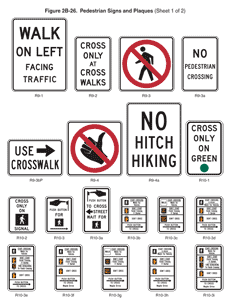

Standard:
02 If used, the WALK ON LEFT FACING TRAFFIC sign shall be installed on the right-hand side of the road where pedestrians walk on the pavement or shoulder in the absence of pedestrian pathways or sidewalks.
Option:
03 The No Hitchhiking (R9-4) sign (see Figure 2B-26) may be used to prohibit standing in or adjacent to the roadway for the purpose of soliciting a ride. The R9-4a word message sign (see Figure 2B-26) may be used as an alternate to the R9-4 symbol sign.
Section 2B.51 Pedestrian Crossing Signs (R9-2, R9-3)
Option:
01 Pedestrian Crossing signs (see Figure 2B-26) may be used to limit pedestrian crossing to specific locations.
Standard:
02 If used, Pedestrian Crossing signs shall be installed to face pedestrian approaches.
Option:
03 Where crosswalks are clearly defined, the CROSS ONLY AT CROSSWALKS (R9-2) sign may be used to prohibit pedestrians from crossing at locations away from crosswalks.
04 The No Pedestrian Crossing (R9-3) sign may be used to prohibit pedestrians from crossing a roadway at an undesirable location or in front of a school or other public building where a crossing is not designated.
05 The NO PEDESTRIAN CROSSING (R9-3a) word message sign may be used as an alternate to the R9-3 symbol sign. The USE CROSSWALK (R9-3bP) supplemental plaque, along with an arrow, may be installed below either sign to designate the direction of the crossing.
Support:
06 One of the most frequent uses of the Pedestrian Crossing signs is at signalized intersections that have three crossings that can be used and one leg that cannot be crossed.
Guidance:
07 The R9-3bP plaque should not be installed in combination with educational plaques.
Section 2B.52 Traffic Signal Pedestrian and Bicycle Actuation Signs (R10-1 through R10-4, and R10-24 through R10-26)
Standard:
01 Traffic Signal signs applicable to pedestrian actuation (see Figure 2B-26) or bicyclist actuation (see Figure 9B-2) shall be mounted immediately above or incorporated into the pushbutton detector units (see Section 4E.08).
Support:
02 Traffic Signal signs applicable to pedestrians include:
- CROSS ONLY ON GREEN (symbolic circular green) (R10-1);
- CROSS ONLY ON (symbolic walk indication) SIGNAL (R10-2);
- Push Button for Walk Signal (R10-3 series); and
- Push Button for Green Signal (R10-4 series).
Option:
03 The following signs may be used as an alternate for the R10-3 and R10-4 signs:
- Push Button to Cross Street Wait for Walk Signal (R10-3a); or
- Push Button to Cross Street Wait for Green Signal (R10-4a).
04 The name of the street to be crossed may be substituted for the word STREET in the legends on the R10-3a and R10-4a signs.
Guidance:
05 The finger in the pushbutton symbol on the R10-3, R10-3a, R10-4, and R10-4a signs should point in the same direction as the arrow on the sign.
Option:
06 Where symbol-type pedestrian signal indications are used, an educational sign (R10-3b) may be used instead of the R10-3 sign to improve pedestrian understanding of pedestrian indications at signalized intersections. Where word-type pedestrian signal indications are being retained for the remainder of their useful service life, the legends WALK/DONT WALK may be substituted for the symbols on the educational sign R10-3b, thus creating educational sign R10-3c. The R10-3d educational sign may be used to inform pedestrians that the pedestrian clearance time is sufficient only for the pedestrian to cross to the median at locations where pedestrians cross in two stages using a median refuge island. The R10-3e educational sign may be used where countdown pedestrian signals have been provided. In order to assist the pedestrian in understanding which pushbutton to push, the R10-3f to R10-3i educational signs that provide the name of the street to be crossed may be used instead of the R10-3b to R10-3e educational signs.
07 The R10-24 or R10-26 sign (see Section 9B.11) may be used where a pushbutton detector has been installed exclusively to actuate a green phase for bicyclists.
08 The R10-25 sign (see Figure 2B-26) may be used where a pushbutton detector has been installed for pedestrians to activate In-Roadway Warning Lights (see Chapter 4N) or flashing beacons that have been added to the pedestrian warning signs.
Support:
09 Section 4E.08 contains information regarding the application of the R10-32P plaque.
Section 2B.53 Traffic Signal Signs (R10-5 through R10-30)
Option:
01 To supplement traffic signal control, Traffic Signal signs R10-5 through R10-30 may be used to regulate road users.
02 Traffic Signal signs (see Figure 2B-27) may be installed at certain locations to clarify signal control. Among the legends that may be used for this purpose are LEFT ON GREEN ARROW ONLY (R10-5), STOP HERE ON RED (R10-6 or R10-6a) for observance of stop lines, DO NOT BLOCK INTERSECTION (R10-7) for avoidance of traffic obstructions, USE LANE(S) WITH GREEN ARROW (R10-8) for obedience to lane-use control signals (see Chapter 4M), LEFT TURN YIELD ON GREEN (symbolic circular green) (R10-12), and LEFT TURN YIELD ON FLASHING RED ARROW AFTER STOP (R10-27).
Figure 2B-27 Traffic Signal Signs and Plaques
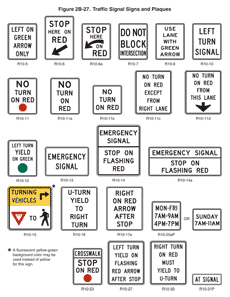
Guidance:
03 If used, the LEFT ON GREEN ARROW ONLY (R10-5) sign, the LEFT TURN YIELD ON GREEN (symbolic circular green) (R10-12) sign, or the LEFT TURN YIELD ON FLASHING RED ARROW AFTER STOP (R10-27) sign should be located adjacent to the left-turn signal face.
Option:
04 If needed for additional emphasis, an additional LEFT TURN YIELD ON GREEN (symbolic circular green) (R10-12) sign with an AT SIGNAL (R10-31P) supplemental plaque (see Figure 2B-27) may be installed in advance of the intersection.
05 In situations where traffic control signals are coordinated for progressive timing, the Traffic Signal Speed (I1-1) sign may be used (see Section 2H.03).
Standard:
06 The CROSSWALK STOP ON RED (symbolic circular red) (R10-23) sign (see Figure 2B-27) shall only be used in conjunction with pedestrian hybrid beacons (see Section 4F.02).
07 The EMERGENCY SIGNAL (R10-13) sign (see Figure 2B-27) shall be used in conjunction with emergency-vehicle traffic control signals (see Section 4G.02).
08 The EMERGENCY SIGNAL—STOP ON FLASHING RED (R10-14 or R10-14a) sign (see Figure 2B-27) shall be used in conjunction with emergency-vehicle hybrid beacons (see Section 4G.04).
Option:
09 In order to remind drivers who are making turns to yield to pedestrians, a Turning Vehicles Yield to Pedestrians (R10-15) sign (see Figure 2B-27) may be used.
10 A U-TURN YIELD TO RIGHT TURN (R10-16) sign (see Figure 2B-27) may be installed near the left-turn signal face if U-turns are allowed on a protected left-turn movement on an approach from which a right-turn GREEN ARROW signal indication is simultaneously being displayed to drivers making a right turn from the conflicting approach to their left.
Section 2B.54 No Turn on Red Signs (R10-11 Series, R10-17a, and R10-30)
Standard:
01 Where a right turn on red (or a left turn on red from a one-way street to a one-way street) is to be prohibited, a symbolic NO TURN ON RED (symbolic circular red) (R10-11) sign (see Figure 2B-27) or a NO TURN ON RED (R10-11a, R10-11b) word message sign (see Figure 2B-27) shall be used.
Guidance:
02 If used, the No Turn on Red sign should be installed near the appropriate signal head.
03 A No Turn on Red sign should be considered when an engineering study finds that one or more of the following conditions exists:
- Inadequate sight distance to vehicles approaching from the left (or right, if applicable);
- Geometrics or operational characteristics of the intersection that might result in unexpected conflicts;
- An exclusive pedestrian phase;
- An unacceptable number of pedestrian conflicts with right-turn-on-red maneuvers, especially involving children, older pedestrians, or persons with disabilities;
- More than three right-turn-on-red accidents reported in a 12-month period for the particular approach; or
- The skew angle of the intersecting roadways creates difficulty for drivers to see traffic approaching from their left.
Option:
04 A supplemental R10-20aP plaque (see Figure 2B-27) showing times of day (similar to the S4-1P plaque shown in Figure 7B-1) with a black legend and border on a white background may be mounted below a No Turn on Red sign to indicate that the restriction is in place only during certain times.
05 Alternatively, a blank-out sign may be used instead of a static NO TURN ON RED sign, to display either the NO TURN ON RED legend or the No Right Turn symbol or word message, as appropriate, only at certain times during the day or during one or more portion(s) of a particular cycle of the traffic signal.
06 On signalized approaches with more than one right-turn lane, a NO TURN ON RED EXCEPT FROM RIGHT LANE (R10-11c) sign (see Figure 2B-27) may be post-mounted at the intersection or a NO TURN ON RED FROM THIS LANE (with down arrow) (R10-11d) sign (see Figure 2B-27) may be mounted directly over the center of the lane from which turns on red are prohibited.
Guidance:
07 Where turns on red are permitted and the signal indication is a steady RED ARROW, the RIGHT (LEFT) ON RED ARROW AFTER STOP (R10-17a) sign (see Figure 2B-27) should be installed adjacent to the RED ARROW signal indication.
Option:
08 A RIGHT TURN ON RED MUST YIELD TO U-TURN (R10-30) sign (see Figure 2B-27) may be installed to remind road users that they must yield to conflicting u-turn traffic on the street or highway onto which they are turning right on a red signal after stopping.
Section 2B.55 Photo Enforced Signs and Plaques (R10-18, R10-19P, R10-19aP)
Option:
01 A TRAFFIC LAWS PHOTO ENFORCED (R10-18) sign (see Figure 2B-3) may be installed at a jurisdictional boundary to advise road users that some of the traffic regulations within that jurisdiction are being enforced by photographic equipment.
02 A Photo Enforced (R10-19P) plaque or a PHOTO ENFORCED (R10-19aP) word message plaque (see Figure 2B-3) may be mounted below a regulatory sign to advise road users that the regulation is being enforced by photographic equipment.
Standard:
03 If used below a regulatory sign, the Photo Enforced (R10-19P or R10-19aP) plaque shall be a rectangle with a black legend and border on a white background.
Section 2B.56 Ramp Metering Signs (R10-28 and R10-29)
Option:
01 When ramp control signals (see Chapter 4I) are used to meter traffic on a freeway or expressway entrance ramp, regulatory signs with legends appropriate to the control may be installed adjacent to the ramp control signal faces.
02 For entrance ramps with only one controlled lane, an XX VEHICLE(S) PER GREEN (R10-28) sign (see Figure 2B-28) may be used to inform road users of the number of vehicles that are permitted to proceed during each short display of the green signal indication. For entrance ramps with more than one controlled lane, an XX VEHICLE(S) PER GREEN Each Lane (R10-29) (see Figure 2B-28) sign may be used to inform road users of the number of vehicles that are permitted to proceed from each lane during each short display of the green signal indication.
Figure 2B-28 Ramp Metering Signs
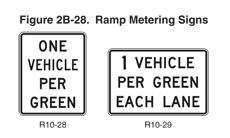
Section 2B.57 KEEP OFF MEDIAN Sign (R11-1)
Option:
01 The KEEP OFF MEDIAN (R11-1) sign (see Figure 2B-29) may be used to prohibit driving into or parking on the median.
Figure 2B-29 Road Closed and Weight Limit Signs
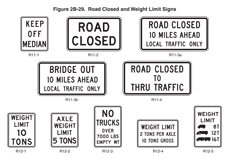
Guidance:
02 The KEEP OFF MEDIAN sign should be installed on the left of the roadway within the median at random intervals as needed wherever there is a tendency for encroachment.
Section 2B.58 ROAD CLOSED Sign (R11-2) and LOCAL TRAFFIC ONLY Signs (R11-3 Series, R11-4)
Guidance:
01 The ROAD CLOSED (R11-2) sign should be installed where roads have been closed to all traffic (except authorized vehicles).
02 ROAD CLOSED—LOCAL TRAFFIC ONLY (R11-3) or ROAD CLOSED TO THRU TRAFFIC (R11-4) signs should be used where through traffic is not permitted, or for a closure some distance beyond the sign, but where the highway is open for local traffic up to the point of closure.
Standard:
03 The Road Closed (R11-2, R11-3 series, and R11-4) signs (see Figure 2B-29) shall be designed as horizontal rectangles. These signs shall be preceded by the applicable Advance Road Closed warning sign with the secondary legend AHEAD and, if applicable, an Advance Detour warning sign (see Section 6F.19).
Option:
04 An intersecting street name or a well-known destination may be substituted for the XX MILES AHEAD legend in urban areas.
05 The word message BRIDGE OUT may be substituted for the ROAD CLOSED legend where applicable.
Section 2B.59 Weight Limit Signs (R12-1 through R12-5)
Option:
01 The Weight Limit (R12-1) sign carrying the legend WEIGHT LIMIT XX TONS may be used to indicate vehicle weight restrictions including load.
02 Where the restriction applies to axle weight rather than gross load, the legend may be AXLE WEIGHT LIMIT XX TONS or AXLE WEIGHT LIMIT XX LBS (R12-2).
03 To restrict trucks of certain sizes by reference to empty weight in residential areas, the legend may be NO TRUCKS OVER XX TONS EMPTY WT or NO TRUCKS OVER XX LBS EMPTY WT (R12-3).
04 In areas where multiple regulations of the type described in Paragraphs 1 through 3 are applicable, a sign combining the necessary messages on a single sign may be used, such as WEIGHT LIMIT XX TONS PER AXLE, XX TONS GROSS (R12-4).
05 Posting of specific load limits may be accomplished by use of the Weight Limit symbol sign (R12-5). A sign containing the legend WEIGHT LIMIT on the top two lines, and showing three different truck symbols and their respective weight limits for which restrictions apply may be used, with the weight limits displayed to the right of each symbol as XX T. A bottom line of legend stating GROSS WT may be included if needed for enforcement purposes.
Standard:
06 If used, the Weight Limit sign (see Figure 2B-29) shall be located in advance of the applicable section of highway or structure.
Guidance:
07 If used, the Weight Limit sign with an advisory distance ahead legend should be placed at approach road intersections or other points where prohibited vehicles can detour or turn around.
Section 2B.60 Weigh Station Signs (R13 Series)
Guidance:
01 An R13-1 sign with the legend TRUCKS OVER XX TONS MUST ENTER WEIGH STATION NEXT RIGHT (see Figure 2B-30) should be used to direct appropriate traffic into a weigh station.
Figure 2B-30 Truck Signs
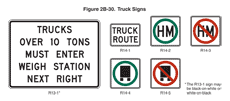
02 The R13-1 sign should be supplemented by the D8 series of guide signs (see Section 2D.49).
Option:
03 The reverse color combination, a white legend and border on a black background, may be used for the R13-1 sign.
Section 2B.61 TRUCK ROUTE Sign (R14-1)
Guidance:
01 The TRUCK ROUTE (R14-1) sign (see Figure 2B-30) should be used to mark a route that has been designated to allow truck traffic.
Option:
02 On a numbered highway, the TRUCK (M4-4) auxiliary sign may be used (see Section 2D.20).
Section 2B.62 Hazardous Material Signs (R14-2, R14-3)
Option:
01 The Hazardous Material Route (R14-2) sign (see Figure 2B-30) may be used to identify routes that have been designated by proper authority for vehicles transporting hazardous material.
02 On routes where the transporting of hazardous material is prohibited, the Hazardous Material Prohibition (R14-3) sign (see Figure 2B-30) may be used.
Guidance:
03 If used, the Hazardous Material Prohibition sign should be installed on a street or roadway at a point where vehicles transporting hazardous material have the opportunity to take an alternate route.
Section 2B.63 National Network Signs (R14-4, R14-5)
Support:
01 The signing of the National Network routes for trucking is optional.
Standard:
02 When a National Network route is signed, the National Network (R14-4) sign (see Figure 2B-30) shall be used.
Option:
03 The National Network Prohibition (R14-5) sign (see Figure 2B-30) may be used to identify routes, portions of routes, and ramps where trucks are prohibited. The R14-5 sign may also be used to mark the ends of designated routes.
Section 2B.64 Headlight Use Signs (R16-5 through R16-11)
Support:
01 Some States require road users to turn on their vehicle headlights under certain weather conditions, as a safety improvement measure on roadways experiencing high crash rates, or in special situations such as when driving through a tunnel.
02 Figure 2B-31 shows the various signs that can be used for informing motorists of these requirements.
Figure 2B-31 Headlight Use Signs

Option:
03 A LIGHTS ON WHEN USING WIPERS (R16-5) sign or a LIGHTS ON WHEN RAINING (R16-6) sign may be installed to inform road users of State laws regarding headlight use. Although these signs are typically installed facing traffic entering the State just inside the State border, they also may be installed at other locations within the State.
Guidance:
04 If a particular section of roadway has been designated as a safety improvement zone within which headlight use is required, a TURN ON HEADLIGHTS NEXT XX MILES (R16-7) sign or a BEGIN DAYTIME HEADLIGHT SECTION (R16-10) sign should be installed at the upstream end of the section, and a END DAYTIME HEADLIGHT SECTION (R16-11) sign should be installed at the downstream end of the section.
Option:
05 A TURN ON HEADLIGHTS (R16-8) sign may be installed to require road users to turn on their headlights in special situations such as when driving through a tunnel. A CHECK HEADLIGHTS (R16-9) sign may be installed downstream from the special situation to inform drivers that the using their headlights is no longer required.
Section 2B.65 FENDER BENDER Sign (R16-4)
Option:
01 A FENDER BENDER MOVE VEHICLES FROM TRAVEL LANES (R16-4) sign (see Figure 2B-32) may be installed to require motorists to move their vehicle out of the travel lanes if they have been involved in a crash.
Figure 2B-32 Other Regulatory Signs and Symbols
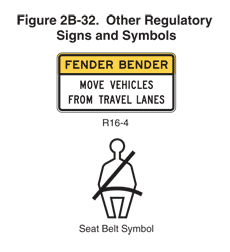
Section 2B.66 Seat Belt Symbol
Standard:
01 When a seat belt symbol is used, the symbol shown in Figure 2B-32 shall be used.
Guidance:
02 The seat belt symbol should not be used alone. If used, the seat belt symbol should be incorporated into regulatory sign messages for mandatory seat belt use.
Section 2B.67 Barricades
Option:
01 Barricades may be used to mark any of the following conditions:
- A roadway ends,
- A ramp or lane closed for operational purposes, or
- The permanent or semi-permanent closure or termination of a roadway.
Standard:
02 When used to warn and alert road users of the terminus of a roadway in other than temporary traffic control zones, barricades shall meet the design criteria of Section 6F.68 for a Type 3 Barricade, except that the colors of the stripes shall be retroreflective white and retroreflective red.
Option:
03 An end-of-roadway marker or markers may be used as described in Section 2C.66.
Guidance:
04 Appropriate advance warning signs (see Chapter 2C) should be used.
Section 2B.68 Gates
Support:
01 Gates described in this section used for weather or other emergency conditions are typically permanently installed to enable the gate to be immediately deployed as needed to prohibit the entry of traffic to the highway segment(s).
02 A gate typically features a gate arm that is moved from a vertical to a horizontal position or is rotated in a horizontal plane from parallel to traffic to perpendicular to traffic. Traffic is obstructed and required to stop when the gate arm is placed in a horizontal position perpendicular to traffic. Another type of gate consists of a segment of fence (usually on rollers) that swings open and closed, or that is retracted to open and then extended to close.
03 Gates are sometimes used to enforce a required stop. Some examples of such uses are the following:
- Parking facility entrances and exits,
- Private community entrances and exits,
- Military base entrances and exits,
- Toll plaza lanes,
- Movable bridges (see Chapter 4J),
- Automated Flagger Assistance Devices (see Chapter 6E), and
- Grade crossings (see Part 8).
04 Gates are sometimes used to periodically close a roadway or a ramp. Some examples of such uses are the following:
- Closing ramps to implement counter-flow operations for evacuations,
- Closing ramps that lead to reversible lanes, and
- Closing roadways for weather events such as snow, ice, or flooding, or for other emergencies.
Standard:
05 Except as provided in Paragraph 6, gate arms, if used, shall be fully retroreflectorized on both sides, have vertical stripes alternately red and white at 16-inch intervals measured horizontally as shown in Figure 8C-1.
Option:
06 If used on a one-way roadway or ramp, the retroreflectorization may be omitted on the side of the gate facing away from approaching traffic.
07 Where gate arms are used to block off ramps into reversible lanes or to redirect approaching traffic, the red and white striping may be angled such that the stripes slope downward at an angle of 45 degrees toward the side of the gate arm on which traffic is to pass.
Standard:
08 The gate arm shall extend across the approaching lane or lanes of traffic to effectively block motor vehicle and/or pedestrian travel as appropriate.
09 When gate arms are in the vertical position or rotated to an open position, the closest part of the gate arm and support shall have a lateral offset of at least 2 feet from the face of the curb or the edge of the traveled way.
10 When gate arms that are located in the median or on an island are in the horizontal position or rotated to a closed position, the closest part of the counterweight or its supports shall have a lateral offset of at least 2 feet from the face of the curb or the edge of the traveled way of the open roadway on the opposite side of the median or island.
Guidance:
11 When a gate that is rotated in a horizontal plane is in the position where it is parallel to traffic (indicating that the roadway is open), the outer end of the gate arm should be rotated to the downstream direction (from the perspective of traffic in the lane adjacent to the gate support) to prevent spearing if the gate is struck by an errant vehicle.
12 If a pedestrian route is present and if it is not intended that pedestrian traffic be controlled by the gate, a minimum of 2 feet of lateral offset from supports, posts, counterweights, and gate mechanisms should be provided when the gate arm is in the open position and when the gate arm is in the closed position such that pedestrian travel is not impeded.
Option:
13 Red lights may be attached to traffic gates.
Standard:
14 If red lights are attached to a traffic gate, the red lights shall be steadily illuminated or flashed only during the period when the gate is in the horizontal or closed position and when the gate is in the process of being opened or closed.
15 Except as provided in Paragraph 16, rolling sections of fence, if used, shall include either a horizontal strip of retroreflectorized sheeting on both sides of the fence with vertical stripes alternately red and white at 16-inch intervals measured horizontally to simulate the appearance of a gate arm in the horizontal position, or one or more Type 4 object markers (see Section 2C.66), or both. If a horizontal strip of retroreflectorized sheeting is used, the bottom of the sheeting shall be located 3.5 to 4.5 feet above the roadway surface.
Option:
16 If used on a one-way roadway or ramp, the retroreflectorization may be omitted on the side of the fence facing away from approaching traffic.
